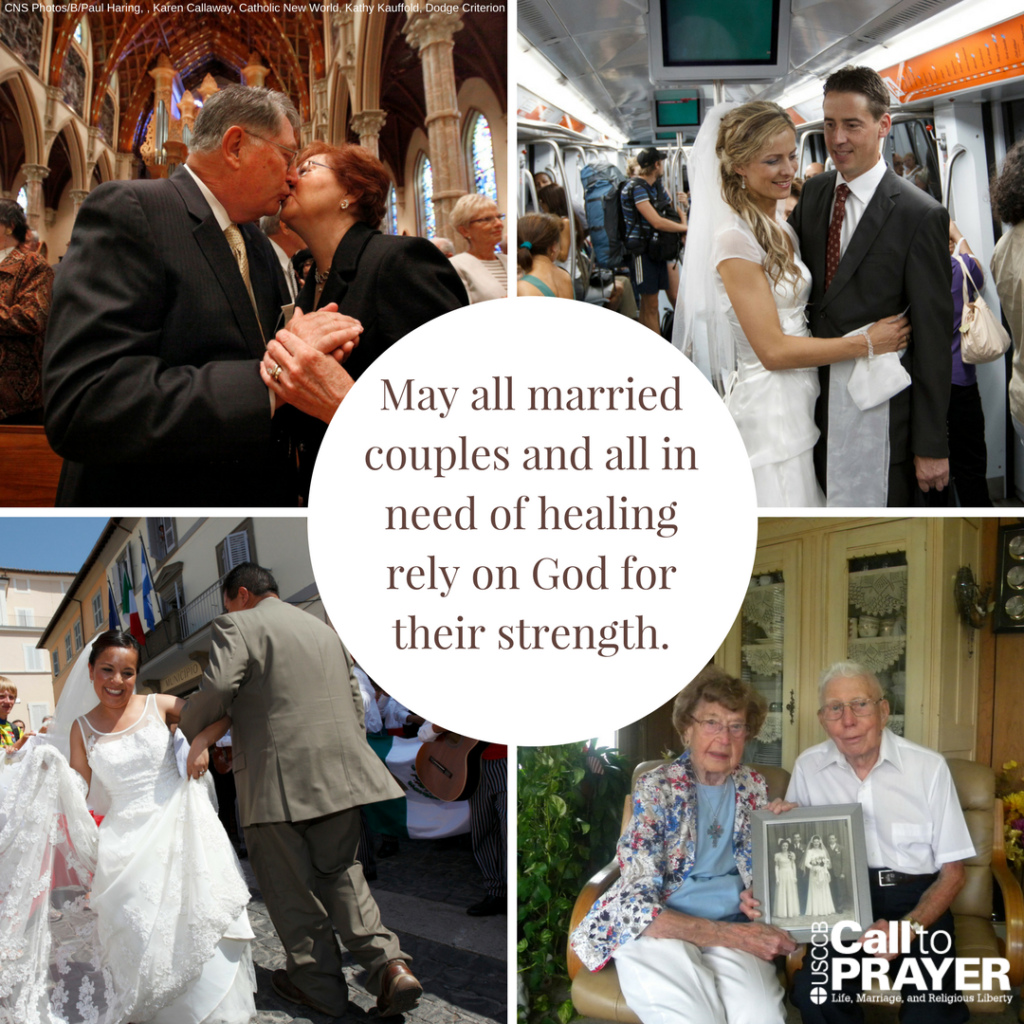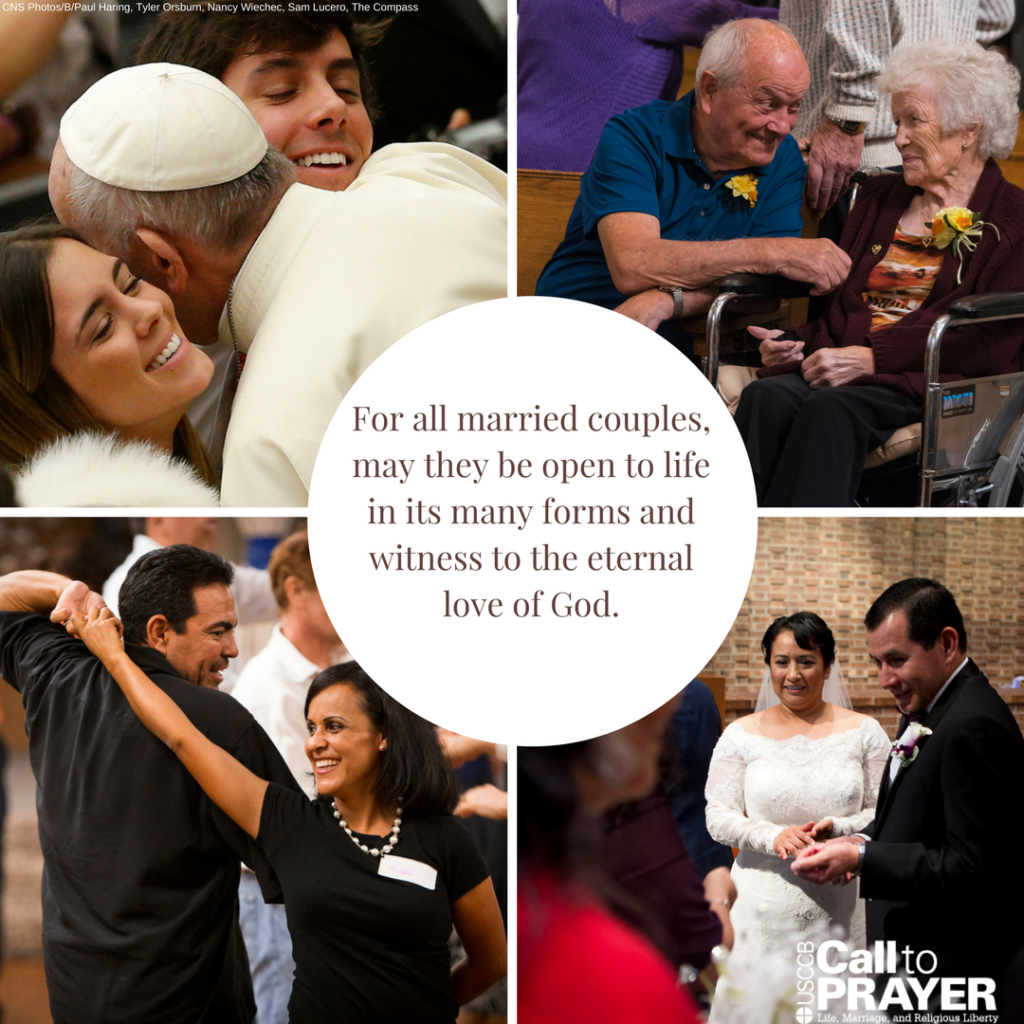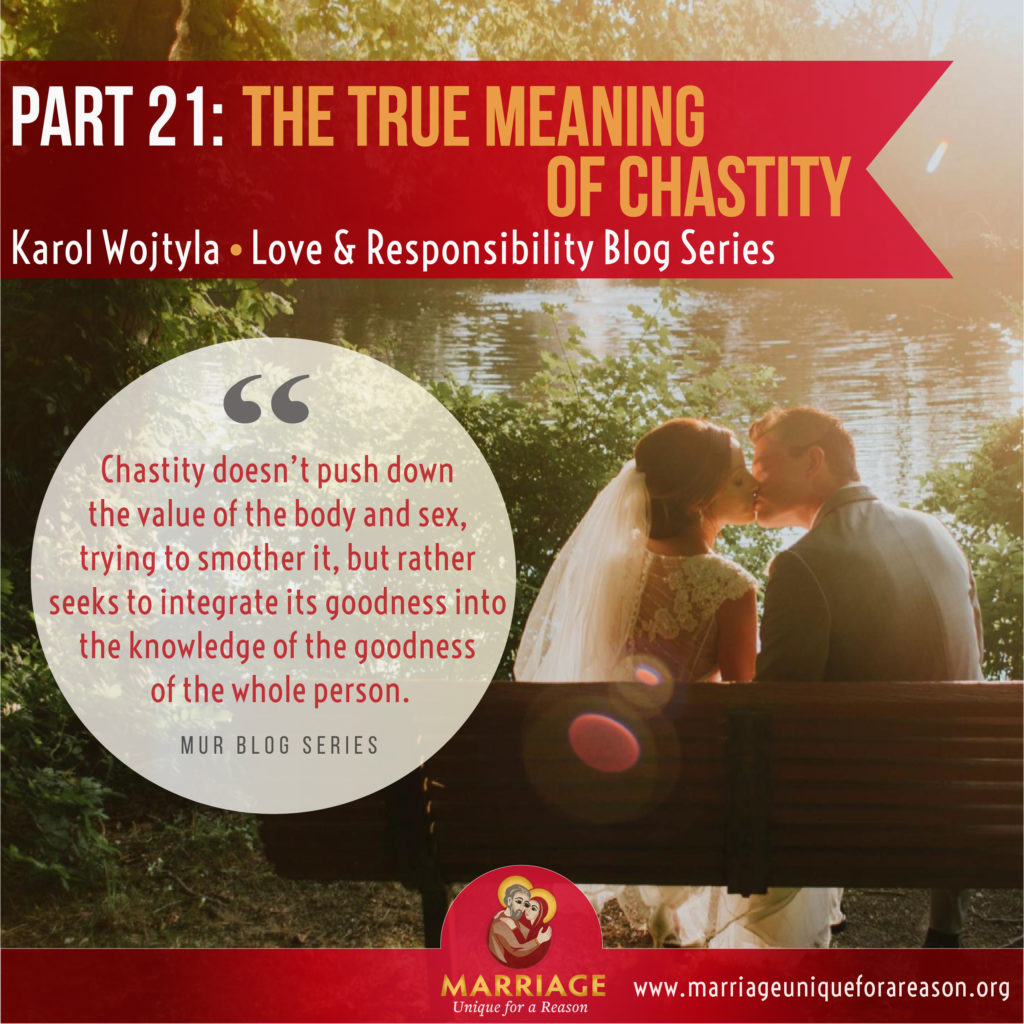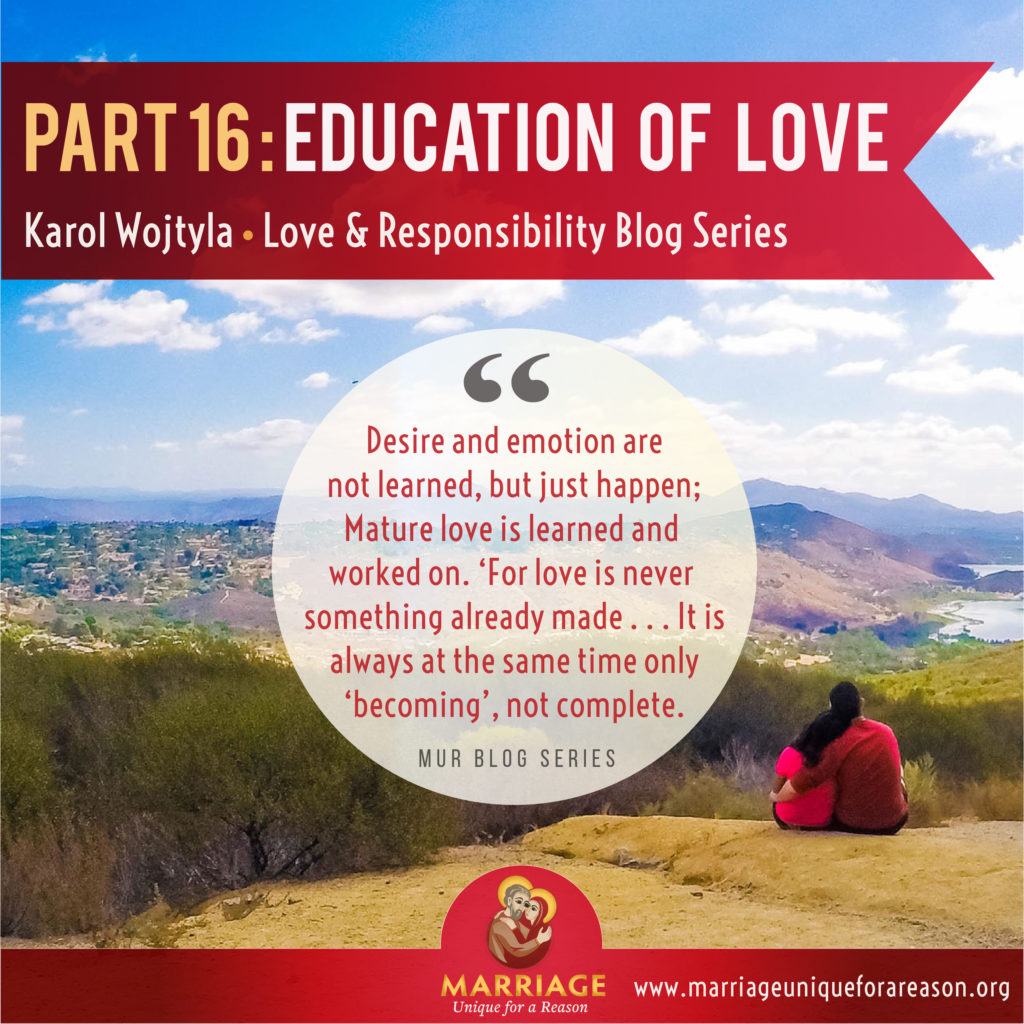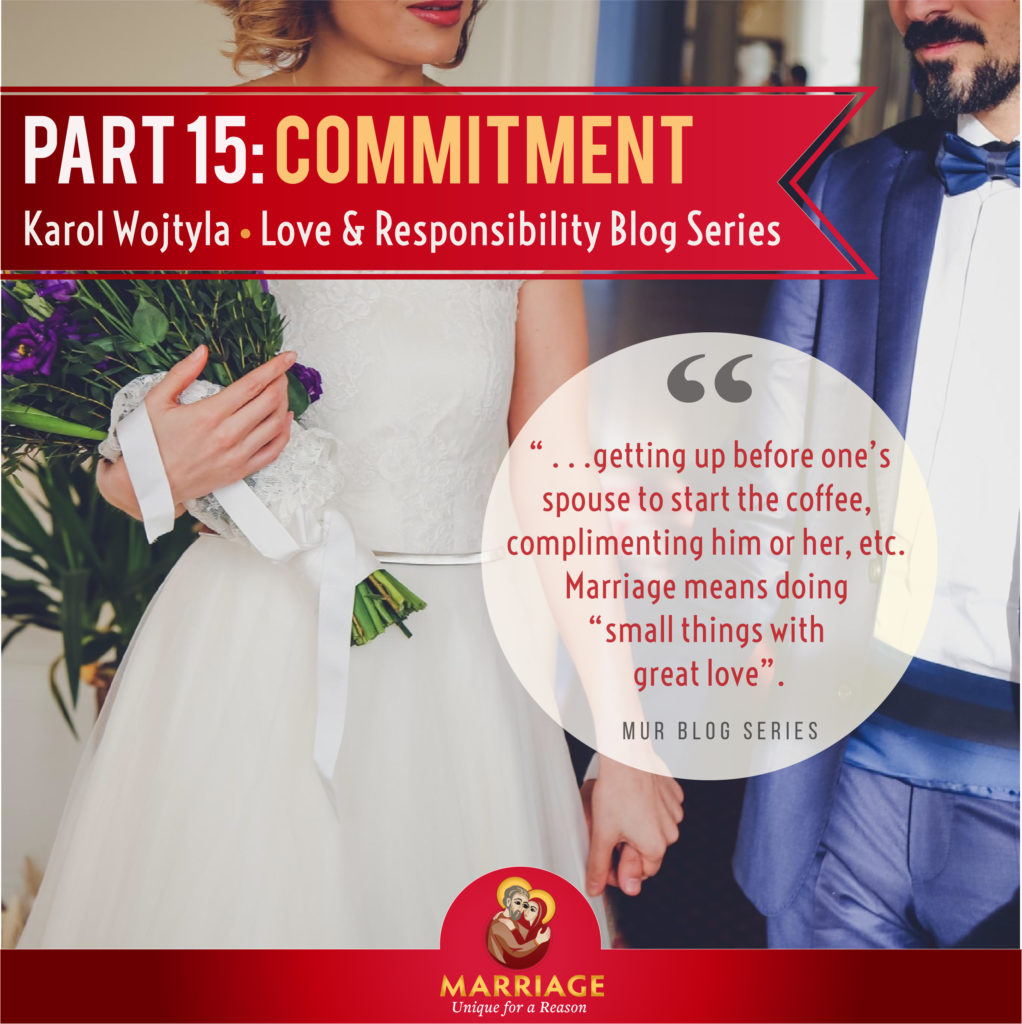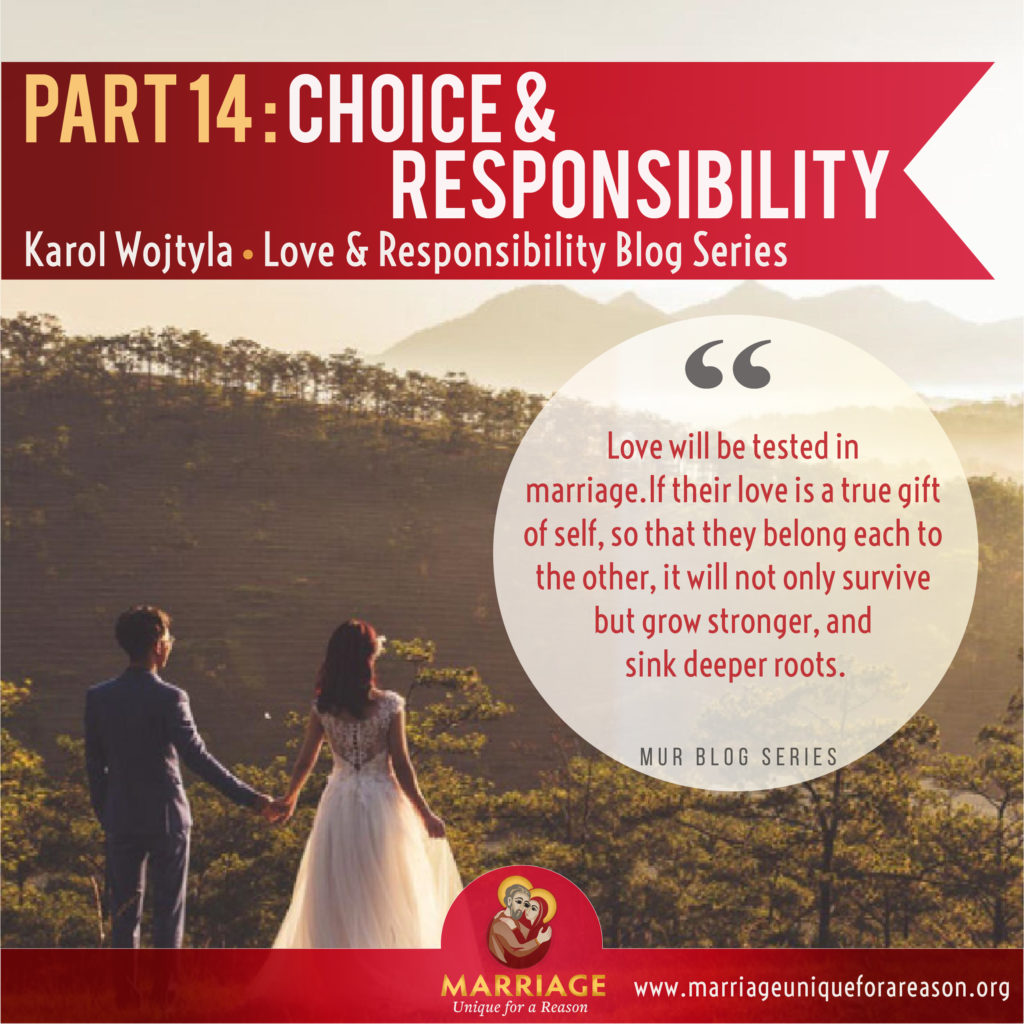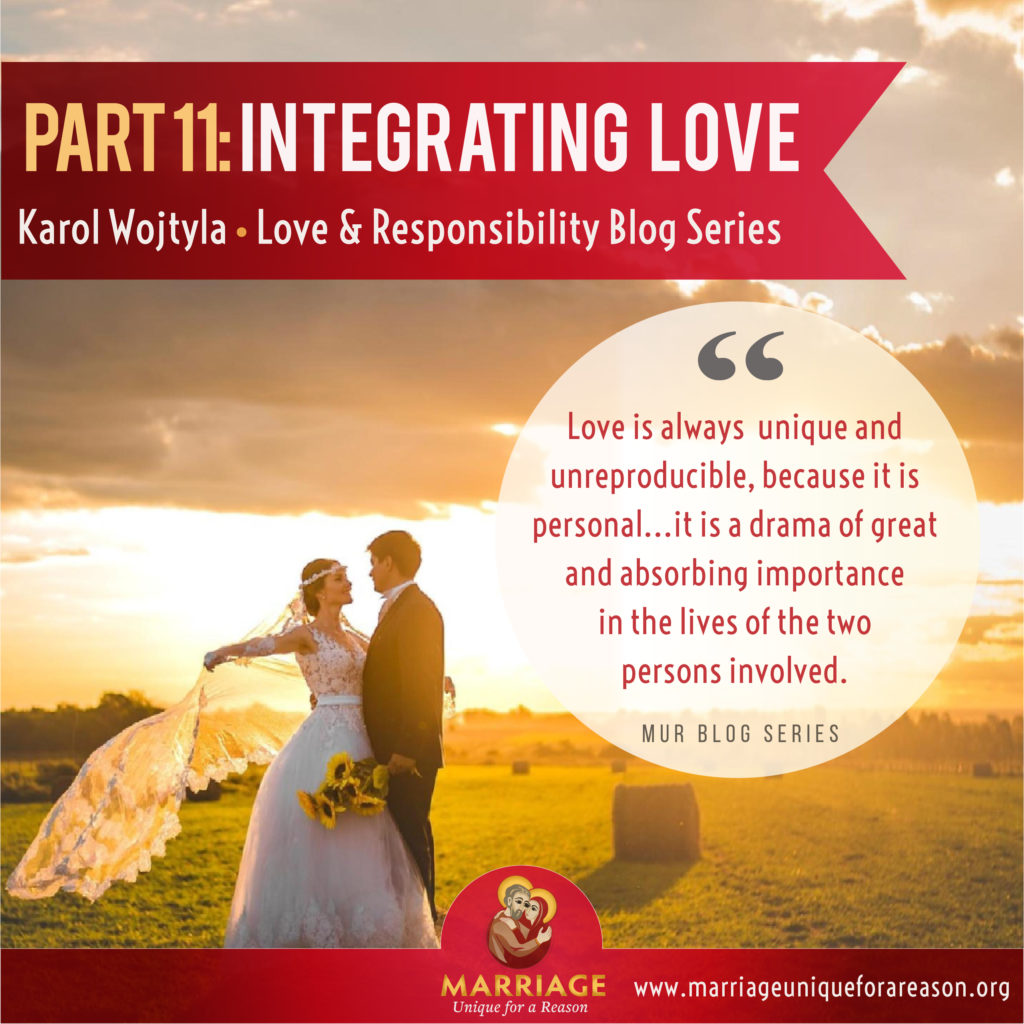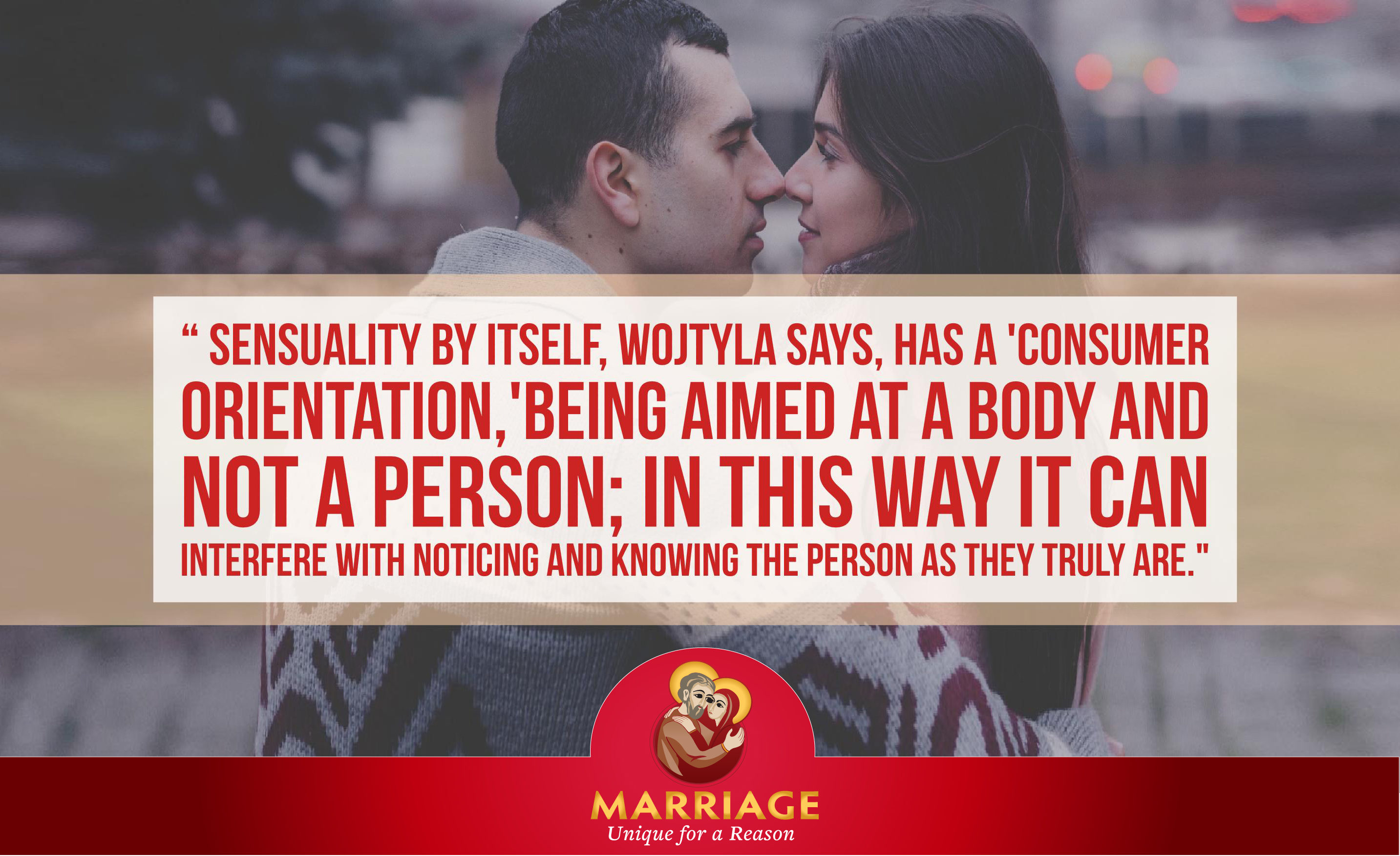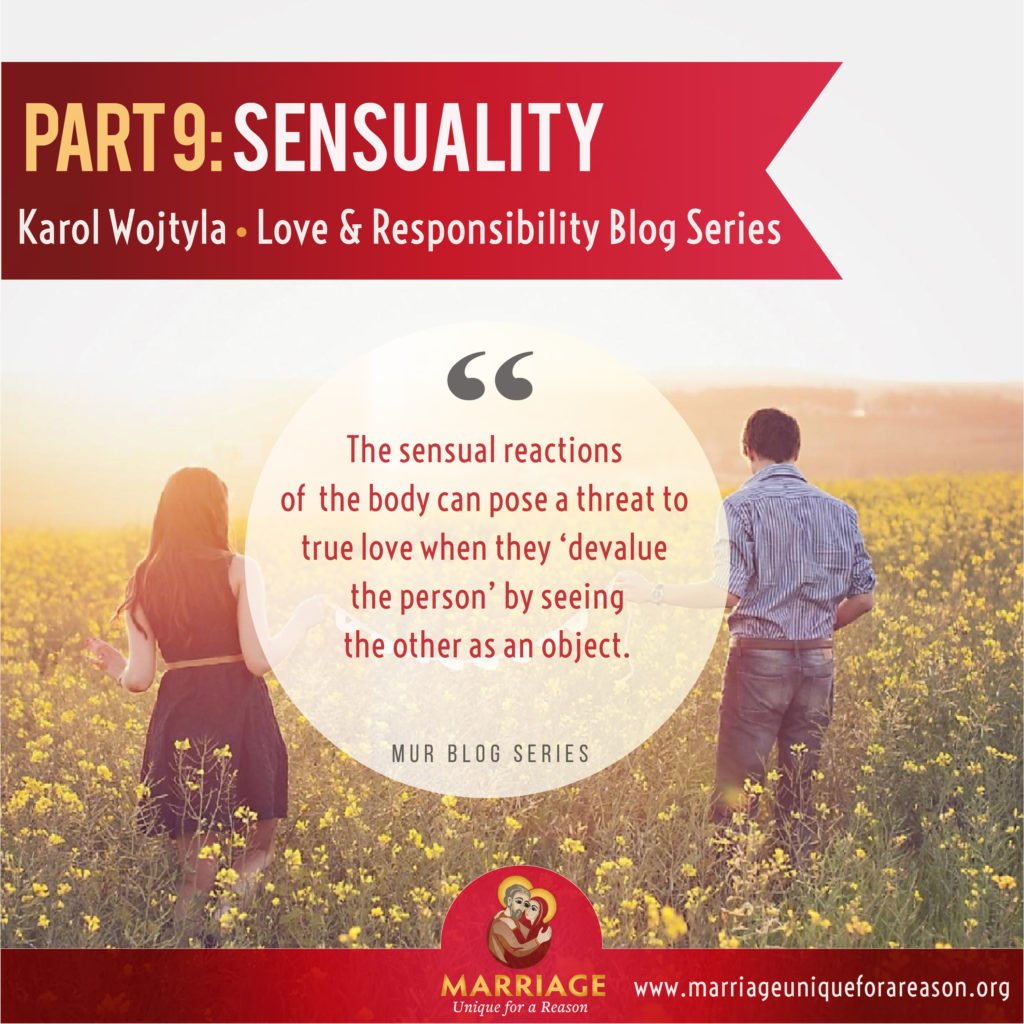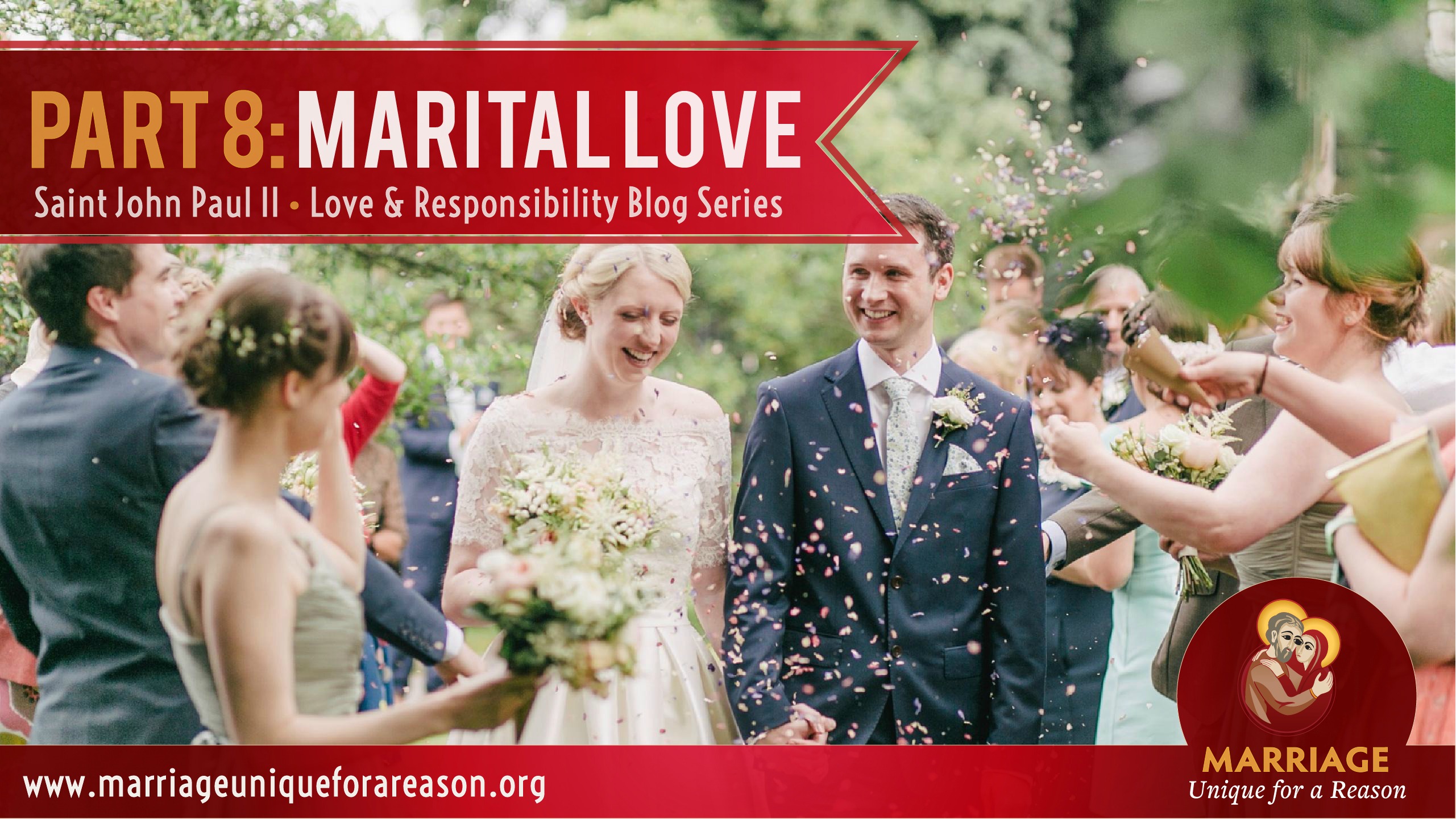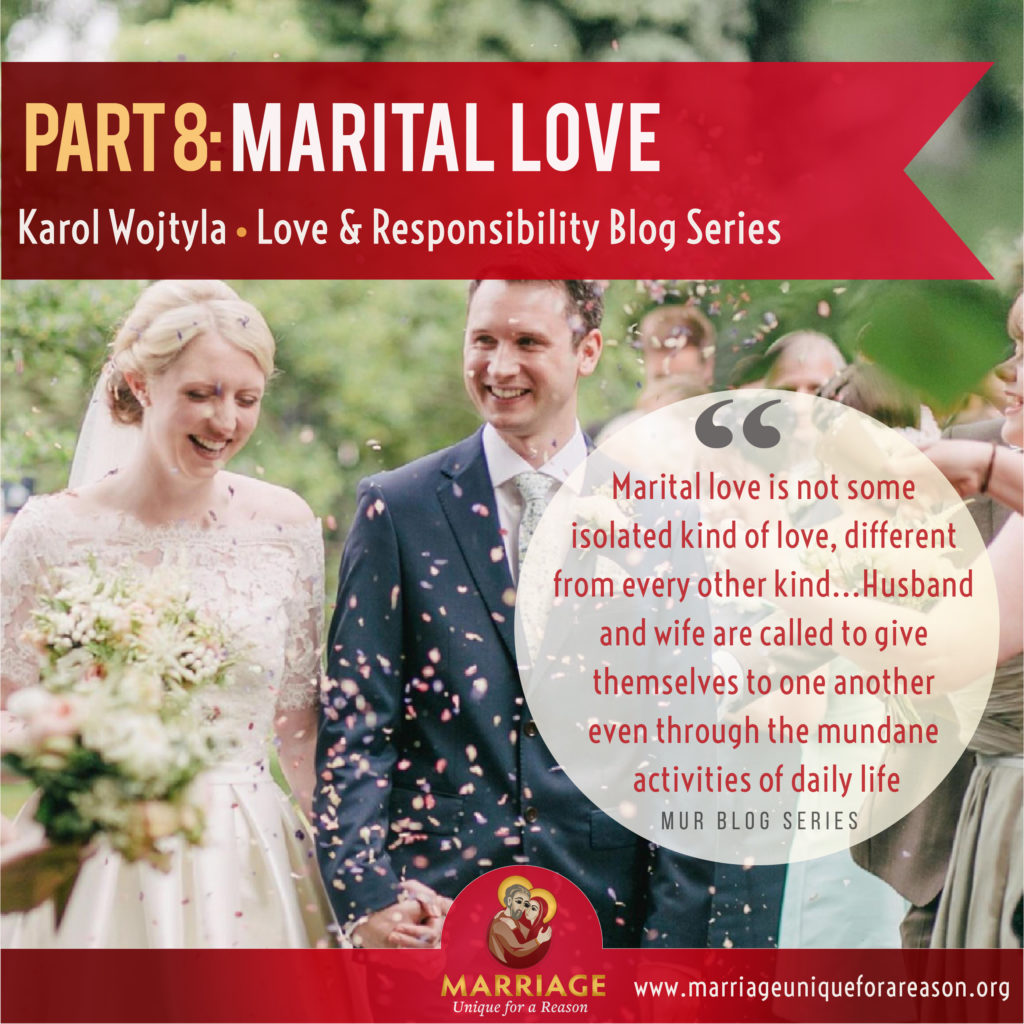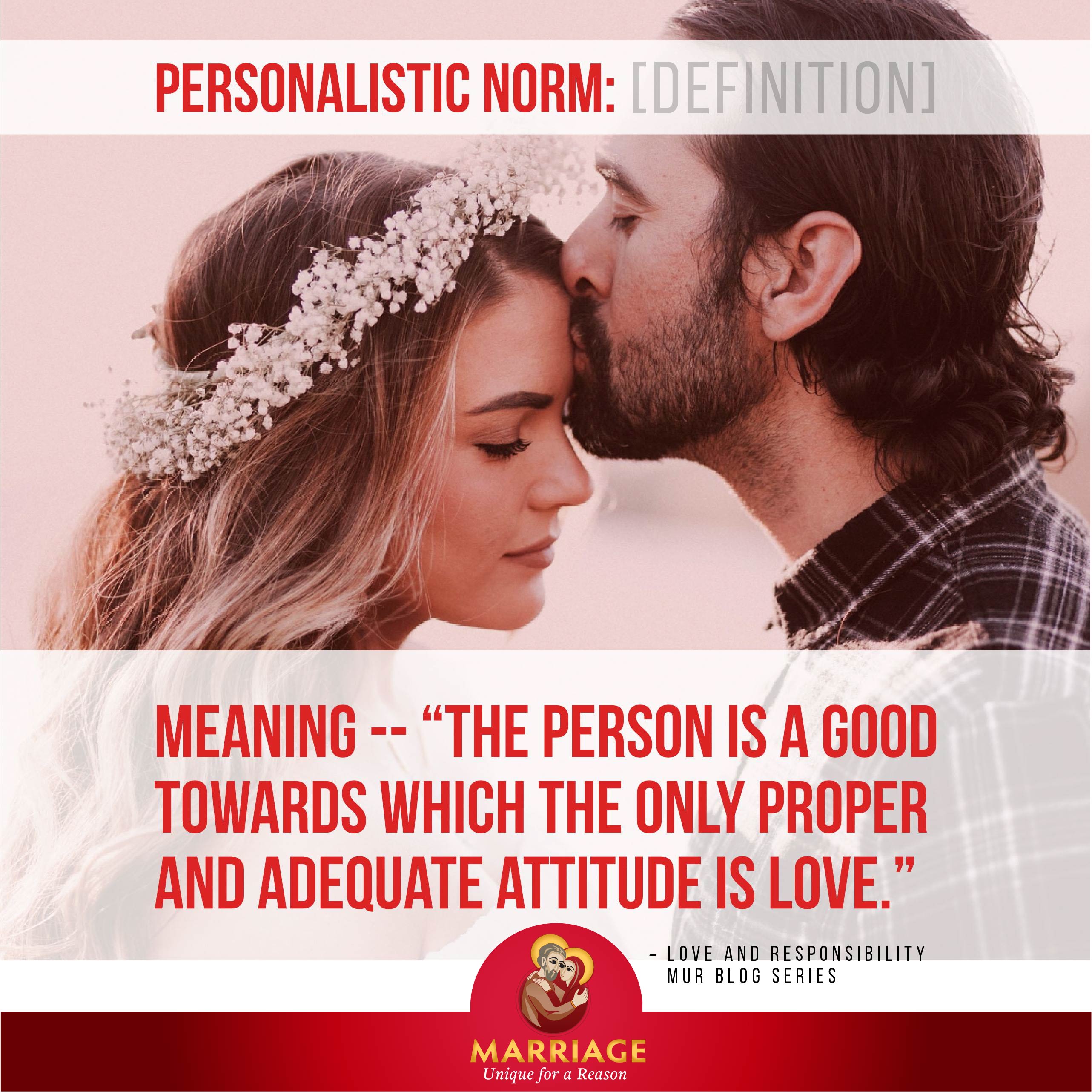Made for Love Ep 6: Reality of Marriage v. the Ideal
The Murphys, Dawsons, and Stouts all thought that because they studied theology, they would be really good at this marriage thing. But knowing the Theology of the Body, while that knowledge is certainly a gift, does not mean your marriage will be easy. The messiness and difficulty of marriage is part of the vocation; it doesn’t mean that you are failing. Listen to these stories of real marriage and its beauty.
Archive
Call to Prayer: February 9, 2018
Archive
Call to Prayer: February 2, 2018
Archive
When Love is Not Love: Made for Love Ep. 3 Show Notes
Stacy and Nabil met in college. Their wedding day was the happiest day of Stacy’s life. But within a few years, they were divorced and Stacy was petitioning for an annulment. What happened? This episode explores the complex issue of annulment in the Catholic Church and features Stacy Thomlison, Fr. Bob Cannon of the Archdiocese of the Military Services, and Alice Heinzen, the marriage and family life director from the Diocese of La Crosse.
To learn more about the annulment process, speak to a priest at your local parish or call the marriage and family life director for your diocese. They will be able to listen to your story and help guide you.
To read up on Catholic teaching on annulments, head here for some FAQ’s: http://www.foryourmarriage.org/catholic-marriage/church-teachings/annulments/
There are links on the bottom of the article to Vatican documents about the annulment process, including the most recent revision that Pope Francis instituted. And here’s the USCCB webpage all about annulments.
Stacy is part of the Fellowship of Catholic University Students, which is an effective evangelization ministry. I saw her give a talk to the National Council of Catholic Women, which was founded by the U.S. Bishops in 1920.
Here’s a story about Fr. Bob Cannon that gives more of his background (and a picture!) http://www.milarch.org/father-robert-r-cannon-ch-col-usaf-named-ams-chancellor/
Here are some articles that Alice Heinzen has written that you may be interested in: https://www.catholicmatch.com/institute/author/aheinzen/
Alice and her husband Jeff were able to speak to the bishops assembled in Rome for the Extraordinary Synod on the Family in 2014. Read their testimony here: https://zenit.org/articles/synod14-testimony-of-mr-and-mrs-jeffrey-heinzen-diocese-of-la-crosse-usa/
Archive
The True Meaning of Chastity: Love and Responsibility (Post #21)
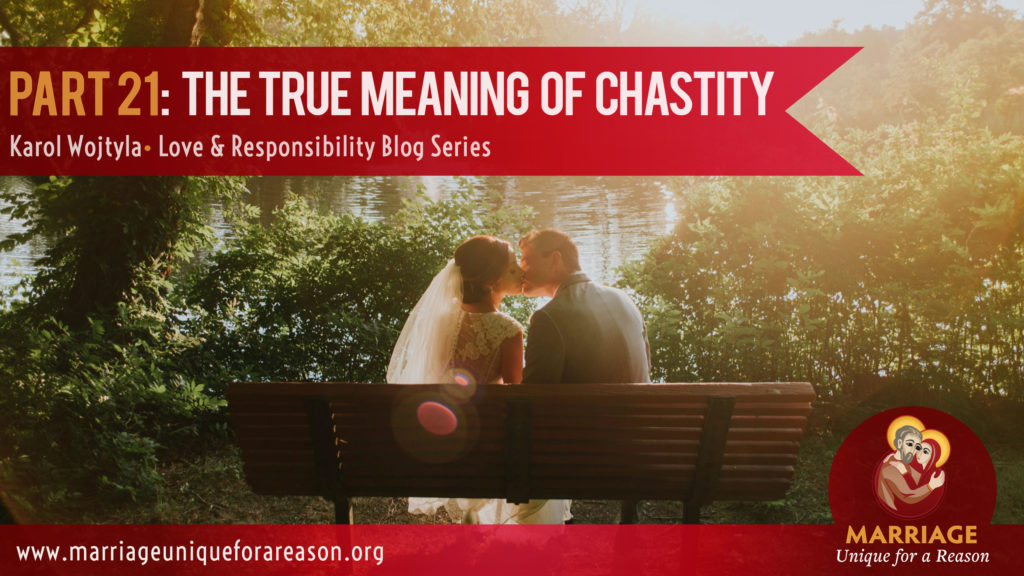 Note bene: This blog post includes a quote from the newer translation by Grzegorz Ignatik of Love and Responsibility—this translation is more readable and may be in some ways more faithful to the original, but the blog post author is most familiar with the H.T. Willets translation and that is why it has been used more!
Note bene: This blog post includes a quote from the newer translation by Grzegorz Ignatik of Love and Responsibility—this translation is more readable and may be in some ways more faithful to the original, but the blog post author is most familiar with the H.T. Willets translation and that is why it has been used more!
Chastity as Virtue:
Where does chastity fit in the general pursuit of virtue? This is what Wojtyla seeks to answer in this section of Love and Responsibility. Aquinas places chastity under the cardinal virtue of temperance[1], or moderation, by which reason moderates physical drives (for food, drink, and 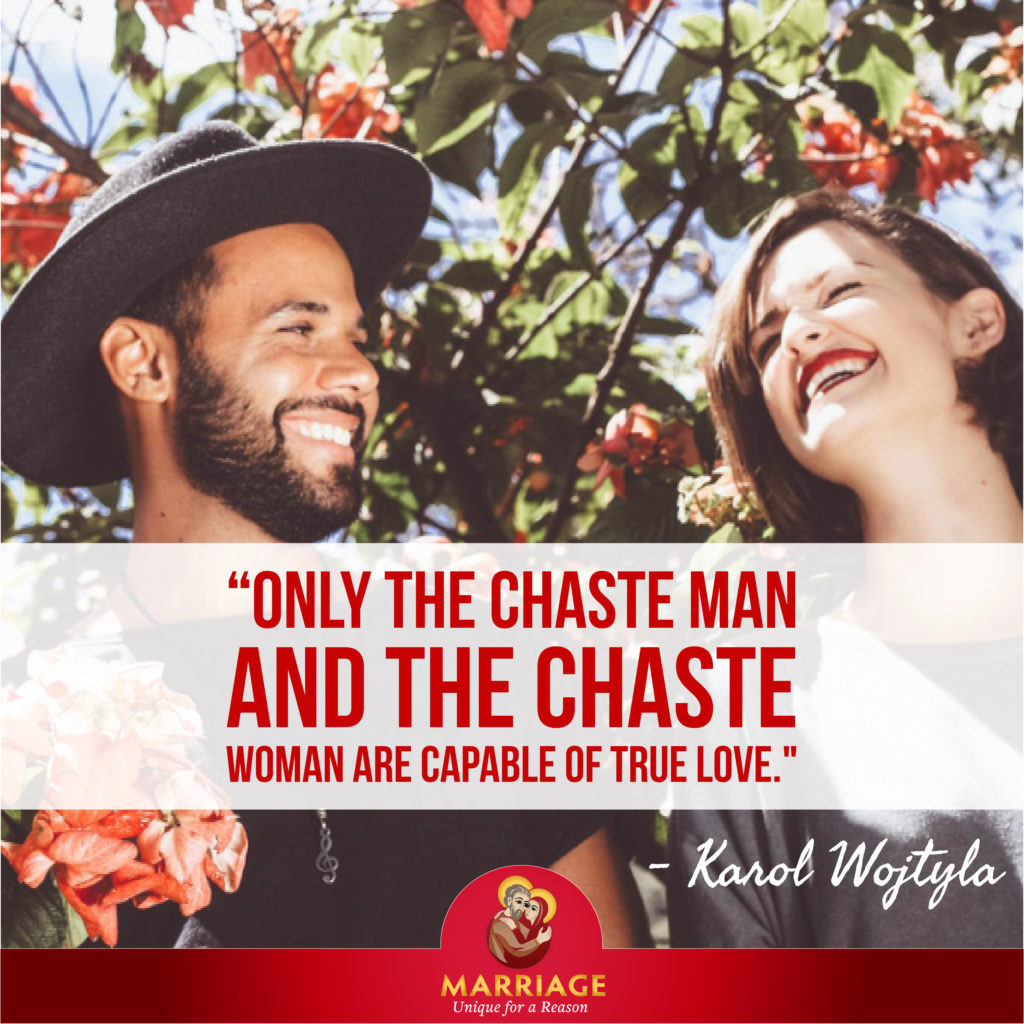 sex). Thus for Aquinas, chastity, as a sub-virtue of moderation, is having control over one’s sensual desire, such that the person is in a more or less permanent state of control (in the will).
sex). Thus for Aquinas, chastity, as a sub-virtue of moderation, is having control over one’s sensual desire, such that the person is in a more or less permanent state of control (in the will).
Wojtyla asks, is that really the best way to think about chastity? As self-control? No, he argues, “There is no way to comprehend chastity without the virtue of love.”[i] The virtue of chastity cannot only consist in control over one’s impulses, but rather control of “those centres deep within the human being in which the utilitarian attitude is hatched and grows.”[ii] This is much harder, and much easier, than acquiring chastity as moderation. It’s harder because looking at yourself honestly and working to root out self-centeredness and a tendency to use others is the work of a lifetime. And yet, once you engage in this deeper work you are much less likely to fall into particular sins related to lust or emotional manipulation. A virtue makes doing what is right easy and joyful. It becomes “co-natural” and it is no longer a real question or temptation because the will is solidly grounded in the understanding of the value of the person.
Consider pornography, for example. There will always be external temptations to view pornography, but the man or woman who has internalized and gained the virtue of chastity does not experience these temptations in the same way that 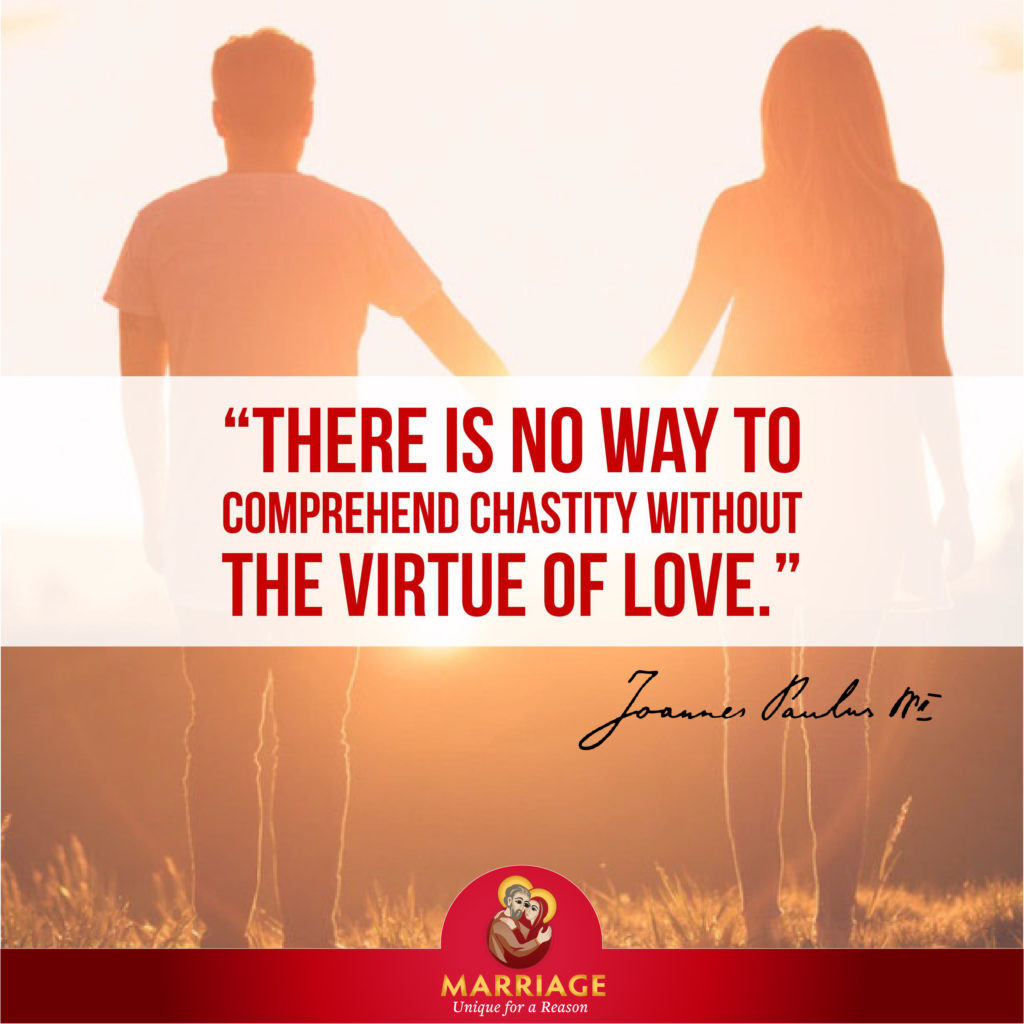 someone who does not have the virtue does. He or she knows in their mind that pornography degrades a human being, and has chosen with his or her will, over and over again, to reject it, such that pornography loses much of its power.[2]
someone who does not have the virtue does. He or she knows in their mind that pornography degrades a human being, and has chosen with his or her will, over and over again, to reject it, such that pornography loses much of its power.[2]
The Goodness of the Whole Person:
“To be chaste,” Wojtyla writes, “means to have a ‘transparent’ attitude to a person of the other sex… the desire to ‘enjoy’ is subordinated to a readiness to show loving kindness in every situation.”[iii] Wojtyla reiterates that chastity does not mean “artificially banishing the values of the ‘body’ or more generally the values of sex to the subconscious, of pretending that they do not exist or at any rate have no effect.”[iv] That is not a good idea. As Wojtyla notes, this false idea of chastity lends itself to “explosions” of sexual desire after repression.[v] Such repression happens when one sees chastity only as a negative virtue (a “no”), “whereas it is above all the ‘yes’ of which certain ‘no’s’ are the consequence.”[vi] Chastity’s essence is 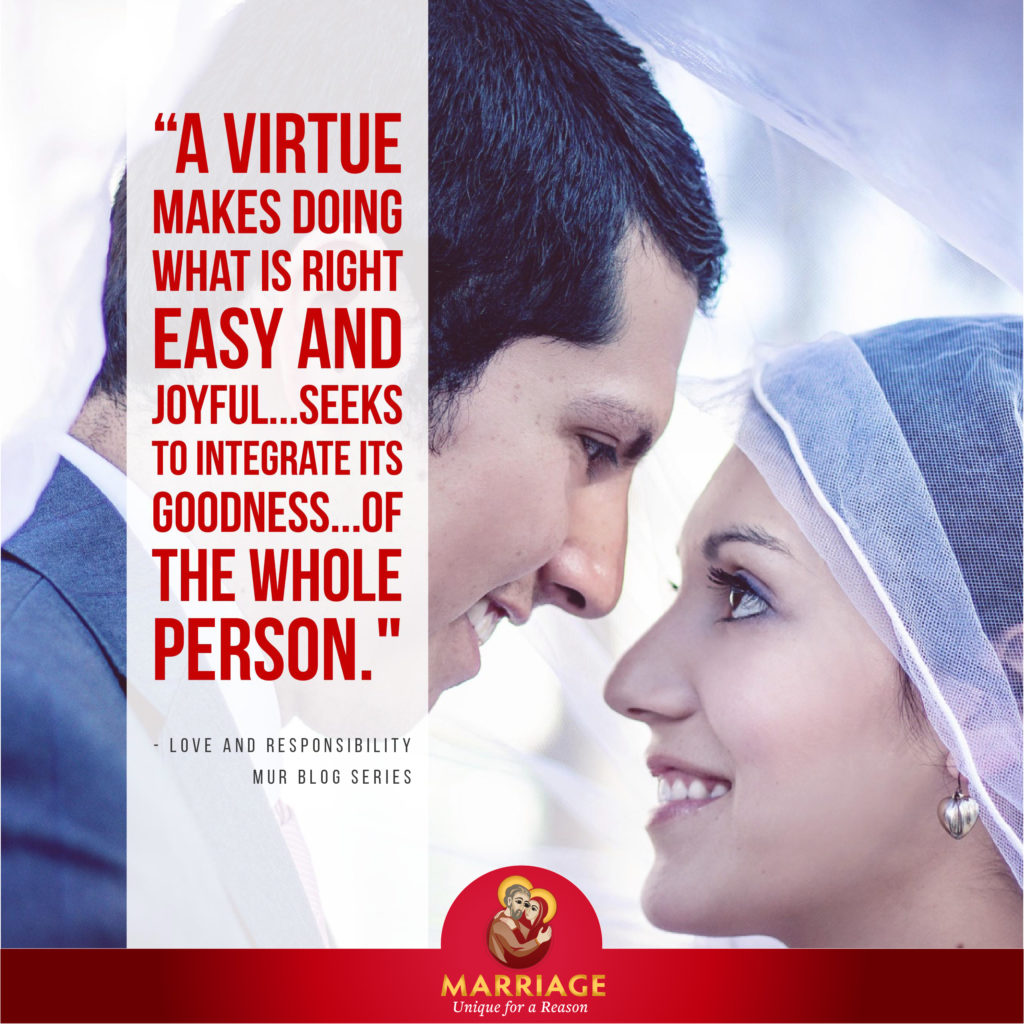 “quickness to affirm the value of the person in every situation and in raising to the personal level all reactions to the value of ‘the body and sex.’”[vii] It doesn’t push down the value of the body and sex, trying to smother it, but rather seeks to integrate its goodness into the knowledge of the goodness of the whole person. As Wendy Shalit wrote about modesty (a sub-virtue of chastity) in A Return to Modesty:
“quickness to affirm the value of the person in every situation and in raising to the personal level all reactions to the value of ‘the body and sex.’”[vii] It doesn’t push down the value of the body and sex, trying to smother it, but rather seeks to integrate its goodness into the knowledge of the goodness of the whole person. As Wendy Shalit wrote about modesty (a sub-virtue of chastity) in A Return to Modesty:
“Whether she decides to have scores of men or none, promiscuous
and prudish women in some sense embrace the same flippant world view,
which one might call the nothing-fazes-me world view. As types, they rep-
resent two sides of the same unerotic coin, which flips over arrogantly and
announces to the world when it lands, “Ha!—I cannot be moved.” Modesty
is prudery’s true opposite, because it admits that one can be moved and
issues a specific invitation for one man to try.”[viii]
If sexual reactions were always bad or undesirable, how could marriage be considered good or holy? “True chastity does not lead to disdain for the body or to disparagement of matrimony and the sexual life,”[ix] Wojytla writes. “That is the result of false chastity, chastity with a tinge of hypocrisy, or, still more frequently, of unchastity.”[x] A person who has not integrated their sexual reactions into a deeper affirmation of the person will see all sexual reactions as ‘dirty.’ “Thus only the chaste man and the chaste woman are capable of true love.”[xi] Chastity frees a couple from using each other and gives them the ability to love in their marital 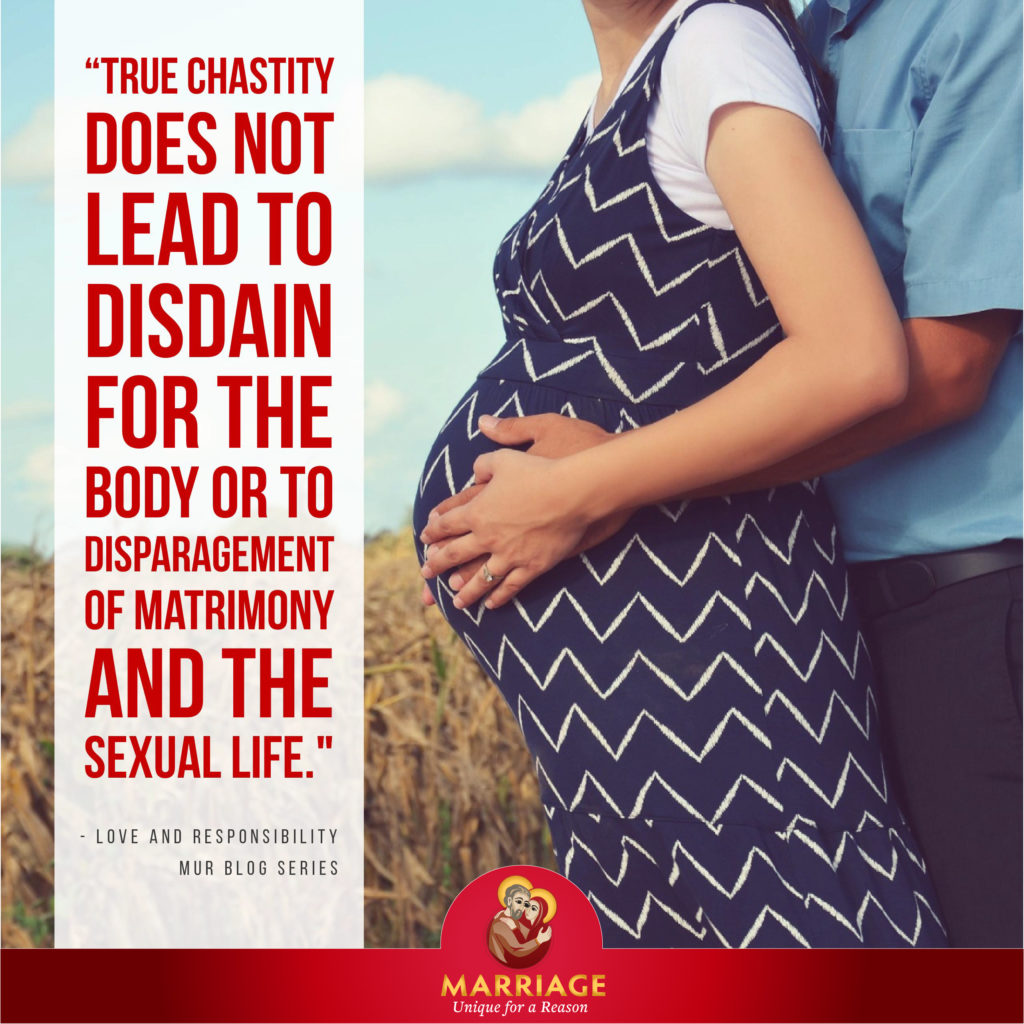 sexual relationship.[xii] This requires maturity of many kinds, since concupiscence remains. “For this reason, chastity is a difficult, long term matter; one must wait patiently for it to bear fruit.”[xiii]
sexual relationship.[xii] This requires maturity of many kinds, since concupiscence remains. “For this reason, chastity is a difficult, long term matter; one must wait patiently for it to bear fruit.”[xiii]
Finally, Wojytla writes about the “humility of the body,” which he asserts is necessary for love.[xiv] “The human body must ‘humble itself’ in face of the magnitude represented by love… subordinate itself [to love].”[xv] Instead of the person striving to satisfy the body’s desires, the chaste person basically says to the body, “Not so fast! This is a person, and he/she is a child of God, destined for heaven.” Thus the body is subordinated to the ultimate happiness of the person. For, “Blessed are the pure in heart, for they shall see God” (Mt. 5:8).
[1] If you need a little refresher, the cardinal virtues are the four “big” virtues, under which other virtues fall. They are prudence, temperance, justice, and fortitude.
[2] This is one of the reasons that early exposure to pornography is so harmful to the person—it snatches away, if you will, the innocent period of time when a child sees everyone as a human person first and only later as a sexual body, and makes it that much harder to develop chastity and a proper view of the human person.
[i] Karol Wojtyla. Love and Responsibility (Boston: Pauline Books and Media, 2013), p. 154.
[ii] Wojtyla, Karol. Love and Responsibility (San Francisco: Ignatius Press, 1993), p. 170.
[iii] Ibid, p. 170.
[iv] Ibid, p. 170.
[v] Ibid, p. 170.
[vi] Ibid, p. 170.
[vii] Ibid, p. 171.
[viii] Wendy Shalit. A Return to Modesty (New York: Touchstone, 1999), p. 182.
[ix] Ibid, p. 171.
[x] Ibid, p. 171.
[xi] Ibid, p. 171.
[xii] Ibid, p. 171.
[xiii] Ibid, p. 172.
[xiv] Ibid, p. 172.
[xv] Ibid, p. 172.
Archive
The Education of Love: Love and Responsibility Series (Post #16)
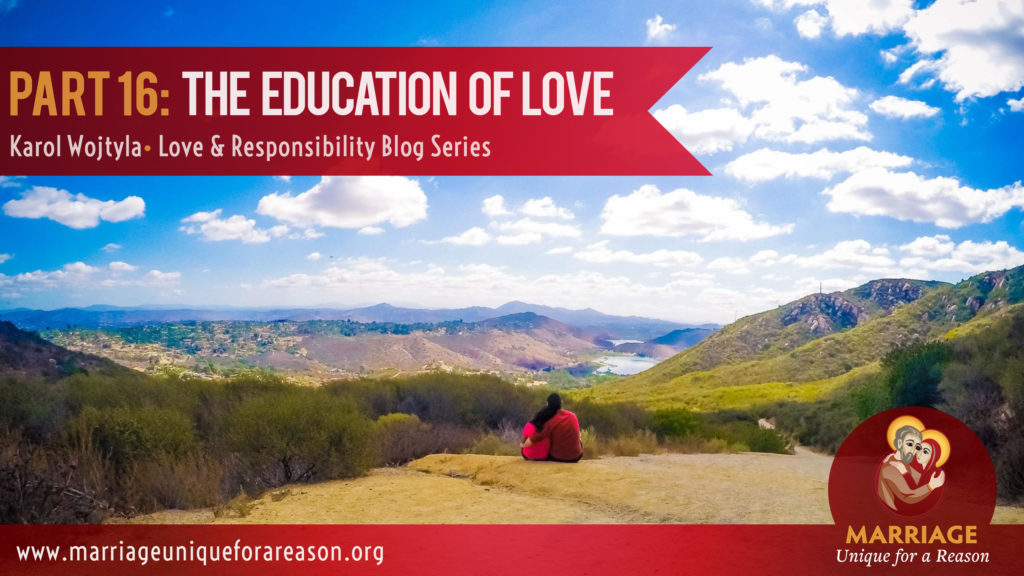
Mature Love is Learned:
Young people may scoff, Wojtyla notes in this section of Love and Responsibility, at the idea that love must be educated, or learned. But the love that a scoffer is are thinking of is the psychological aspect of love, its emotions and desires, not the 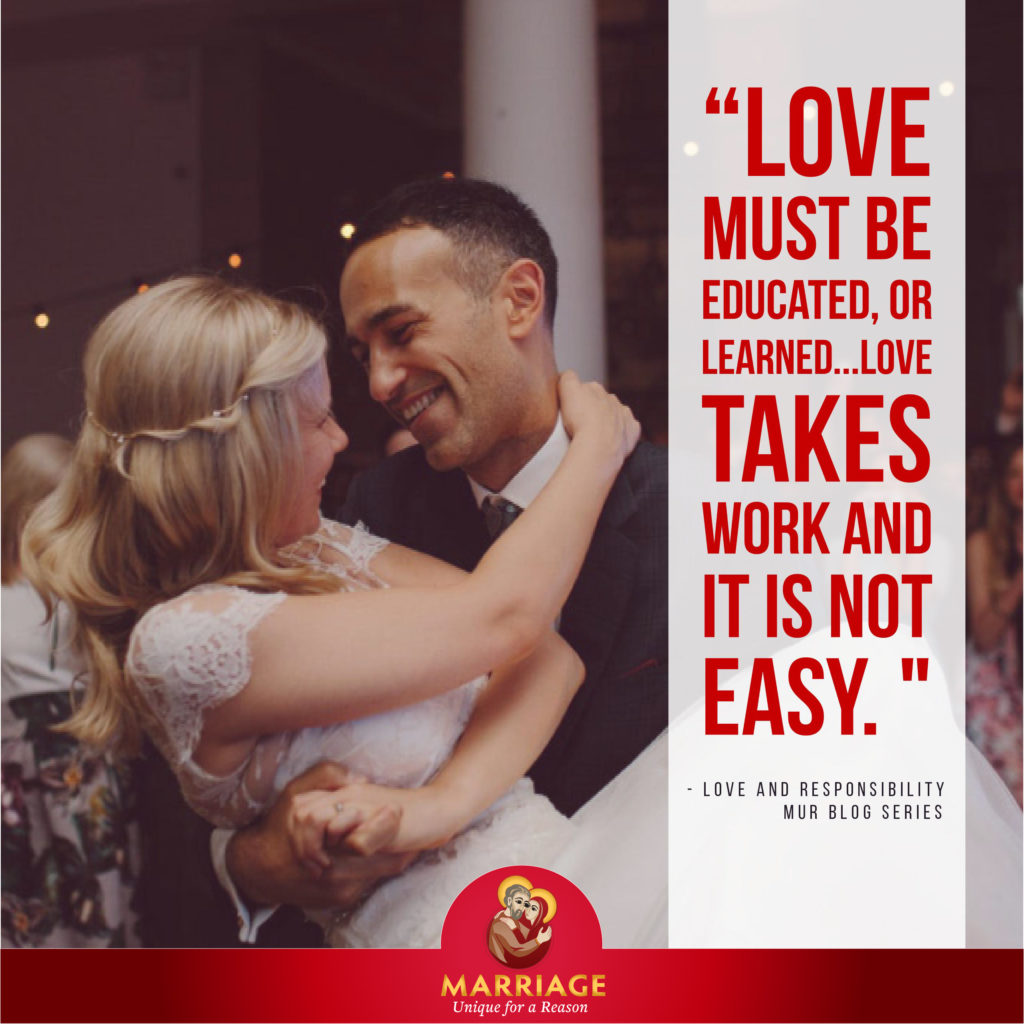 mature love on which a marriage should be based. Desire and emotion are not learned, but just happen; Mature love is learned and worked on. “For love is never something ready made, something merely ‘given’ to man and woman,” Wojtyla writes, “It is always at the same time a ‘task’ which they are set.”[1] Love is like a mission, “Should you choose to accept it” (Mission Impossible). Wojtyla writes that love is always “only ‘becoming’,”[2] not complete. The couple can never brush their hands together and declare, “Okay, now we love each other perfectly! What shall we do next?”
mature love on which a marriage should be based. Desire and emotion are not learned, but just happen; Mature love is learned and worked on. “For love is never something ready made, something merely ‘given’ to man and woman,” Wojtyla writes, “It is always at the same time a ‘task’ which they are set.”[1] Love is like a mission, “Should you choose to accept it” (Mission Impossible). Wojtyla writes that love is always “only ‘becoming’,”[2] not complete. The couple can never brush their hands together and declare, “Okay, now we love each other perfectly! What shall we do next?”
Creators of Love:
Man and woman must continually be creators of their love. They may be given, by God, their past experience, and their natural inclinations, the raw material of attraction or infatuation, but they must make their love by choosing it, over and 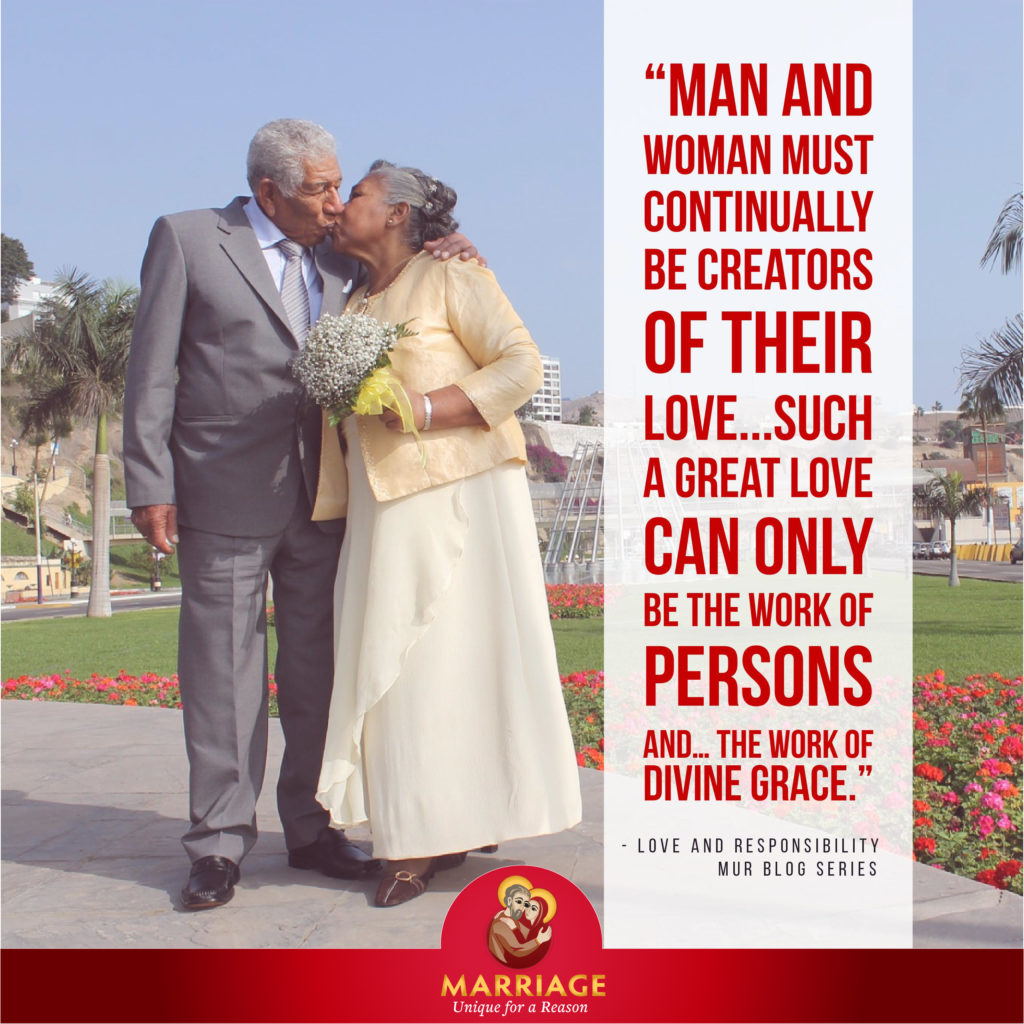 over. Love takes work and it is not easy. “Such a great love can only be the work of persons and… the work of Divine Grace.”[3] Wojtyla notes that sometimes love “follows tortuous ways,” but, “Grace has the power to make straight the paths of human love.”[4] This is the hope that couples can cling to in difficult times. God is with them.
over. Love takes work and it is not easy. “Such a great love can only be the work of persons and… the work of Divine Grace.”[3] Wojtyla notes that sometimes love “follows tortuous ways,” but, “Grace has the power to make straight the paths of human love.”[4] This is the hope that couples can cling to in difficult times. God is with them.
Wojtyla concludes his “Ethical Analysis of Love” here by noting that there is, in the relationship and man and woman, “an insidious possibility of disintegration”[5] (i.e. separation of the desires and emotions from the real choice of the person) which must be countered by developing the virtue of chastity. This is the topic of the next chapter. 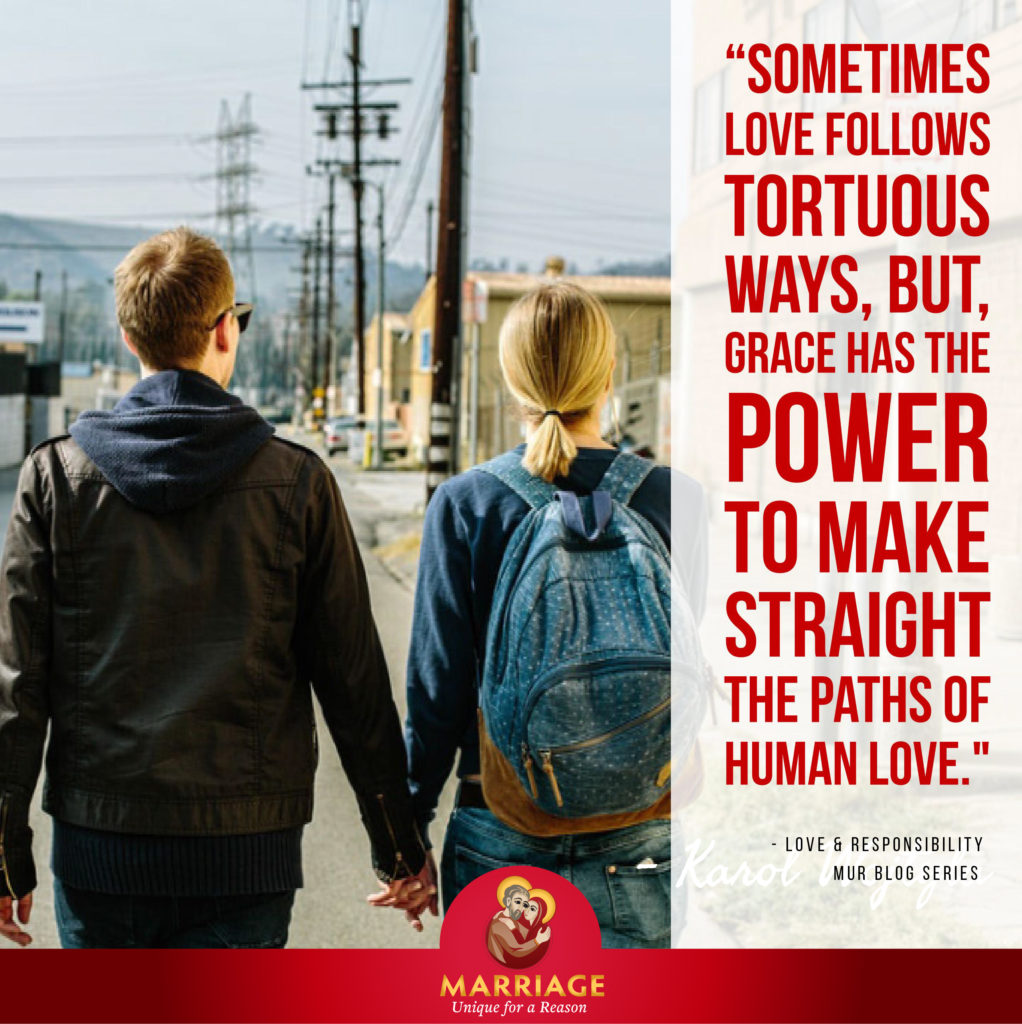
[1] Wojtyla, Karol. Love and Responsibility (San Francisco: Ignatius Press, 1993), p. 139.
[2] Ibid, p. 139.
[3] Ibid, p. 140.
[4] Ibid, p. 140.
[5] Ibid, p. 140.
Archive
Commitment: Love and Responsibility Series (Post #15)
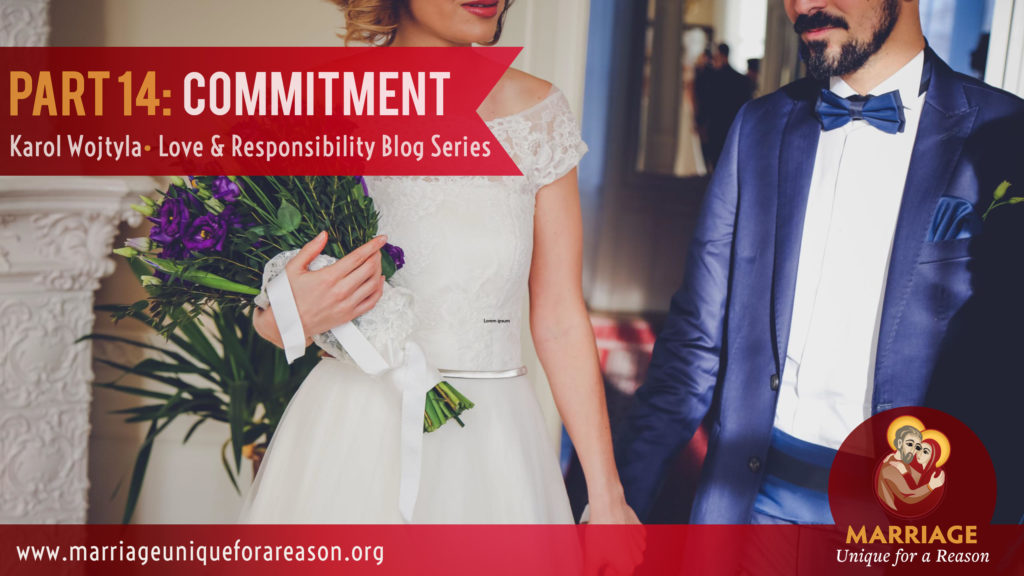
True knowledge for True Love
“Only true knowledge of a person makes it possible to commit one’s freedom to him or her,”[i] Wojtyla writes at the beginning of this section of Love and Responsibility. While giving up or limiting one’s freedom sounds unpleasant (especially to American ears), Wojtyla notes that, “Freedom exists for the sake of love.”[ii] In fact, human beings want to use their freedom to love—and not just to love for a little while but to love in a permanent, irrevocable way. “Forever” is implicit in “I love you,” not something added on. If someone said, “I love you today, but I’m not sure about tomorrow,” the other person would rightly respond, “Then you don’t love me at all.”
Wojtyla notes that the choice of loving another person—keeping in mind that love is the affirmation of the person—must be free. It cannot be made out of coercion or even passion. Wojtyla says that a person’s will “is usually the arena for a struggle 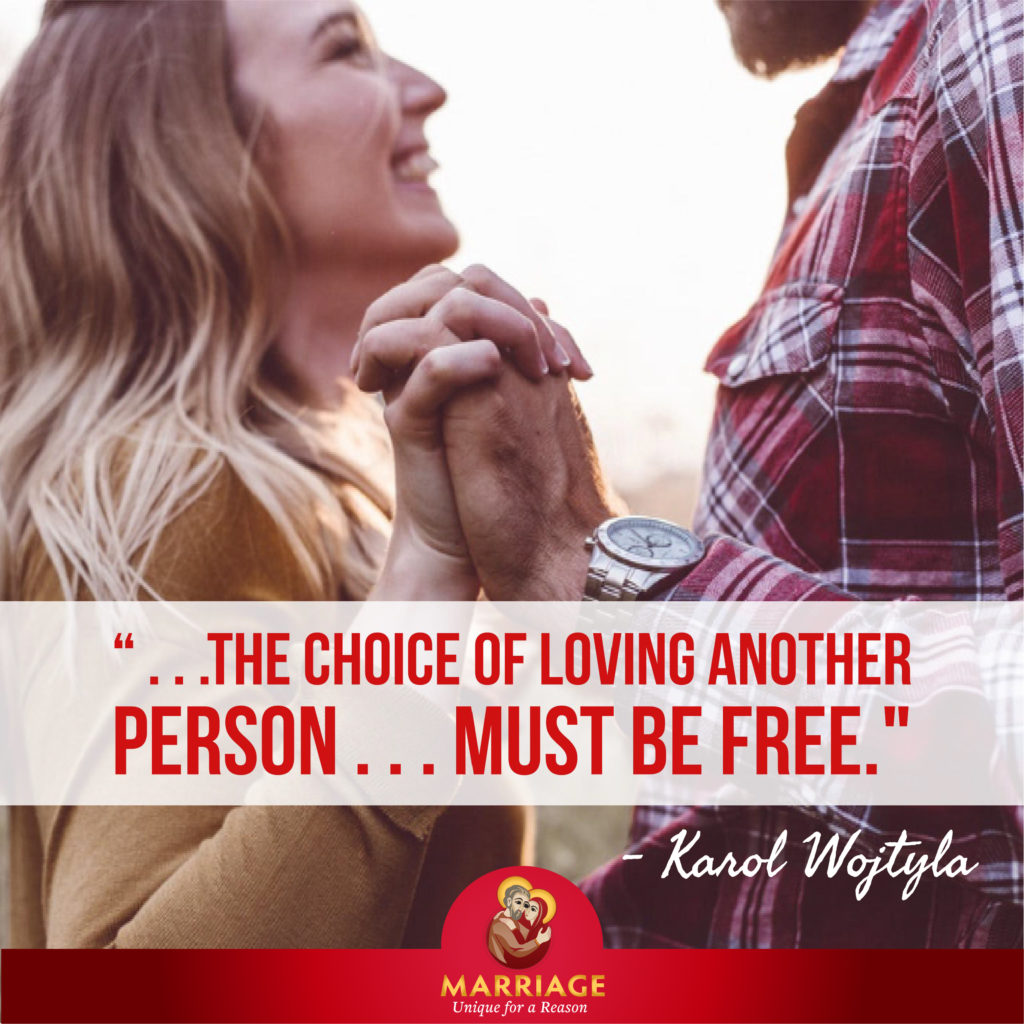 between the sexual instinct and the need for freedom.”[iii] Someone may have to conciously struggle against their bodily desires and emotions in order to see the other person clearly and to treat them as a person, not an object. “Willed love expresses itself above all in the desire of what is good for the beloved person,”[iv] Wojtyla writes.
between the sexual instinct and the need for freedom.”[iii] Someone may have to conciously struggle against their bodily desires and emotions in order to see the other person clearly and to treat them as a person, not an object. “Willed love expresses itself above all in the desire of what is good for the beloved person,”[iv] Wojtyla writes.
Focused on Oneself vs. Focused on the Other
While sexual desire and infatuation, even though they involve another person, are focused on oneself, the will can focus on the other. One can can desire happiness for the other in an unselfish way—and not just momentary happiness but the ultimate happiness of heaven. “[Love in the will] desires the absolute good, the unlimited good, happiness for that person, and in this way compensates and atones for the desire to have that other person, a person of the other sex, for itself.”[v] Rather than denying that the body and emotions are driving someone toward relationships with the other person, the will acknowledges it and seeks to shape and form what is happening into mature love.
Sexual desire and emotional infatuation want to take; love wants to give. This is the “divine aspect of love,”[vi] the fact that to love someone, “is really to desire God for that person.”[vii] In your relationships, can you say that you desire God for 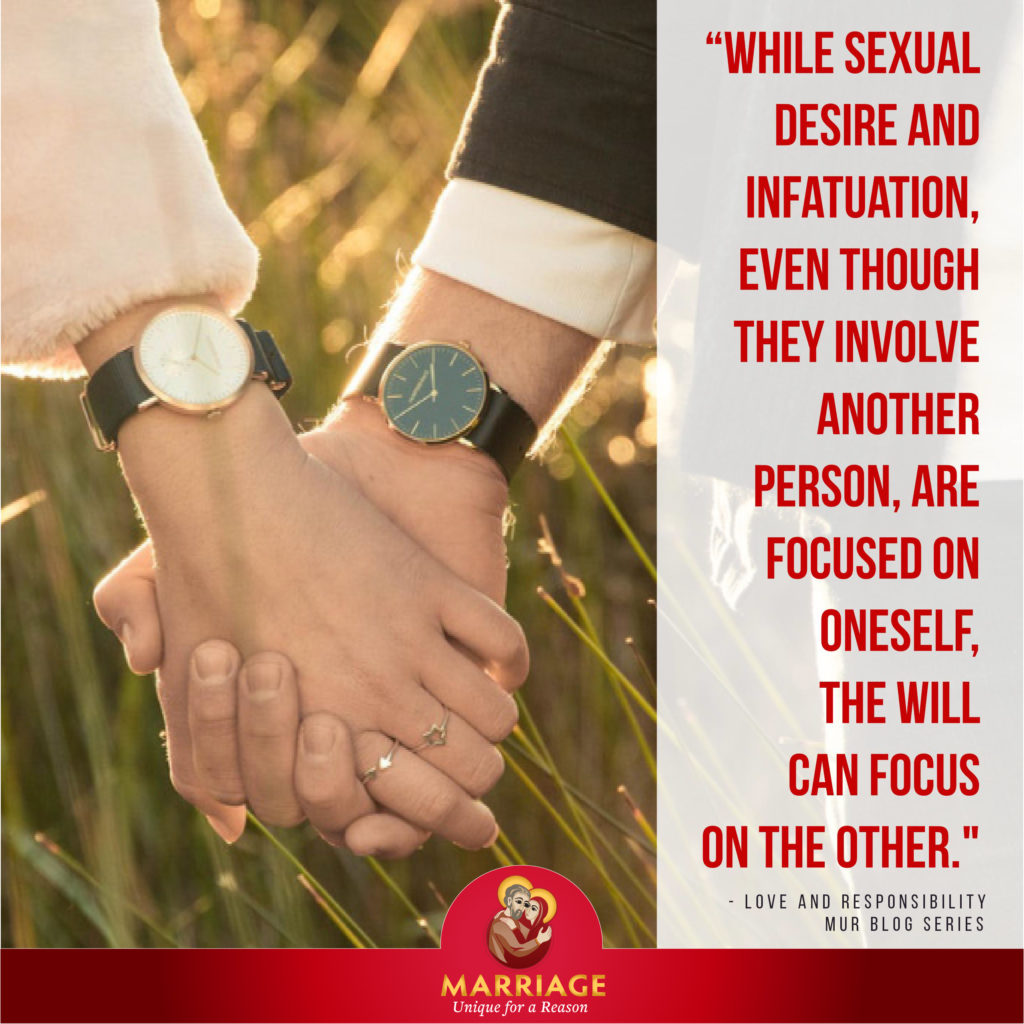 the other person? Wojtyla notes that “only people of profound faith”[viii] see this truth. Wojtyla notes that it is sometimes a great discovery when a person realizes that he can put another person first, freely and joyfully. A person who loves may sacrifice much without thinking too much about it. Think of parents who constantly put their children’s needs before their own. “Love is indeed the highest of moral values. but one must know how to transfer it to the ordinary affairs of everyday life. This is where the problem of educating love arises.”[ix] This ability to love in action shows a person’s capacity for greatness, but this greatness is often manifested in small gestures of tenderness or sacrifice: getting up before one’s spouse to start the coffee, complimenting him or her, etc. Marriage means doing “small things with great love” (as St. [Mother] Teresa of Calcutta would say).
the other person? Wojtyla notes that “only people of profound faith”[viii] see this truth. Wojtyla notes that it is sometimes a great discovery when a person realizes that he can put another person first, freely and joyfully. A person who loves may sacrifice much without thinking too much about it. Think of parents who constantly put their children’s needs before their own. “Love is indeed the highest of moral values. but one must know how to transfer it to the ordinary affairs of everyday life. This is where the problem of educating love arises.”[ix] This ability to love in action shows a person’s capacity for greatness, but this greatness is often manifested in small gestures of tenderness or sacrifice: getting up before one’s spouse to start the coffee, complimenting him or her, etc. Marriage means doing “small things with great love” (as St. [Mother] Teresa of Calcutta would say).
[i] Wojtyla, Karol. Love and Responsibility (San Francisco: Ignatius Press, 1993), p. 135.
[ii] Ibid, p. 135.
[iii] Ibid, p. 136.
[iv] Ibid, p. 137.
[v] Ibid, p. 137.
[vi] Ibid, p. 138.
[vii] Ibid, p. 138.
[viii] Ibid, p. 138.
[ix] Ibid, p. 139.
Archive
Choice and Responsibility: Love and Responsibility Series (Post #14)
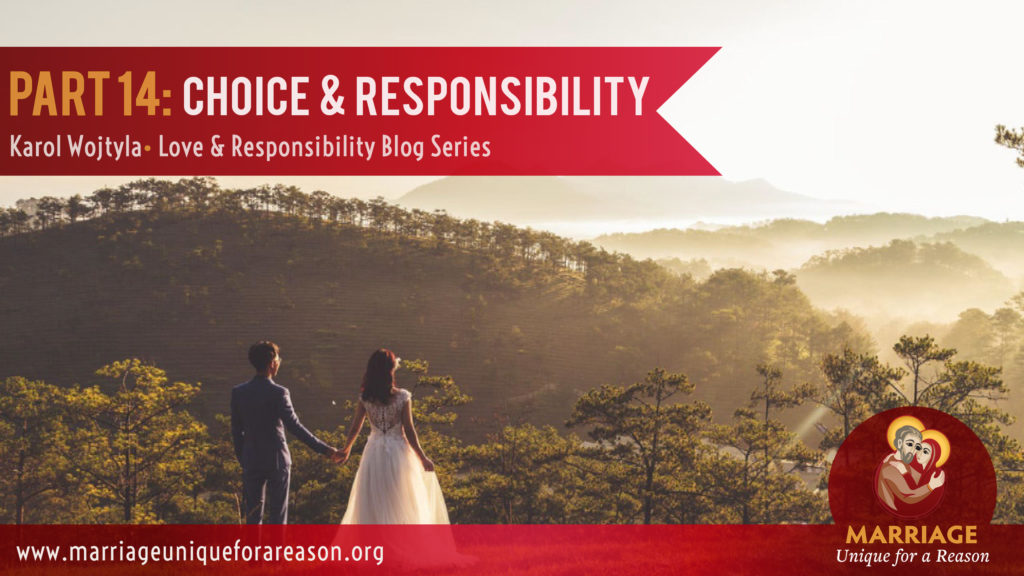
A Responsibility for One’s Own Love:
This part of Love and Responsibility is perhaps the crux of Wojtyla’s argument in the book—“Choice and Responsibility.” A human person has a “responsibility for one’s own love,” he says, and this responsibility is “immense.”[1] It is only recognized as such by someone who understands the value and worth of the human person—a person is a child of God, worth the blood of God’s Son! A person who knows this will be careful about how he or she approaches relationships. Wojtyla notes that a man (or a woman) who does not understand the worth and dignity of others, “will 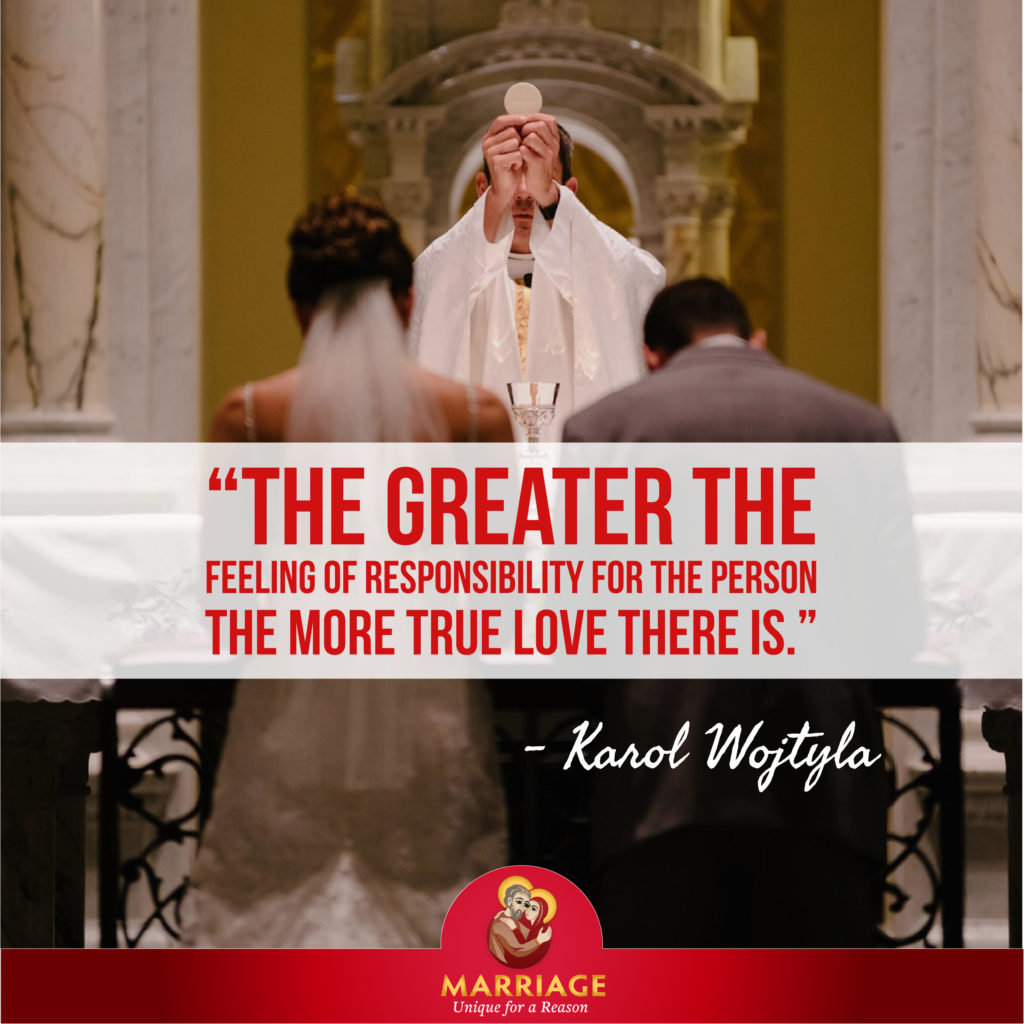 complicate his own life and that of others by letting the reality of love, its true ‘relish,’ escape him.”[2] Someone who never sees the deeper reality of what love is, is bound to hurt other people.
complicate his own life and that of others by letting the reality of love, its true ‘relish,’ escape him.”[2] Someone who never sees the deeper reality of what love is, is bound to hurt other people.
When I read the above, I think of my friend Sally’s[*] father. He left her and her mom when Sally was three; remarried and divorced again when Sally was in elementary school; remarried and divorced again when she was in college… to say that this man “complicated his own life and that of others” is perhaps an understatement. Sally was hurt by every one of those changes and reasonably questions whether marriage can ever be permanent, whether she ever wants to be married. Her father never seemed to care about the effects of his choices on his daughter. He is an example, to me, of a person who does not feel responsibility for other people. Wojtyla says, “The greater the feeling of responsibility for the person the more true love there is.”[3]
Relationships Involve Choices:
Relationships involve choices. Before a man and a woman can pledge their love to one another, “each face the choice of the person on whom to bestow the gift of self. Its consequences makes the choice a weighty matter.”[4] Marriage is (obviously) not a decision to be taken lightly. Dating and engagement ought to be a time of discernment, asking and then verifying that one’s choice of spouse is the right one. Choosing one’s partner in marriage, “is as though one were choosing another ‘I,’ 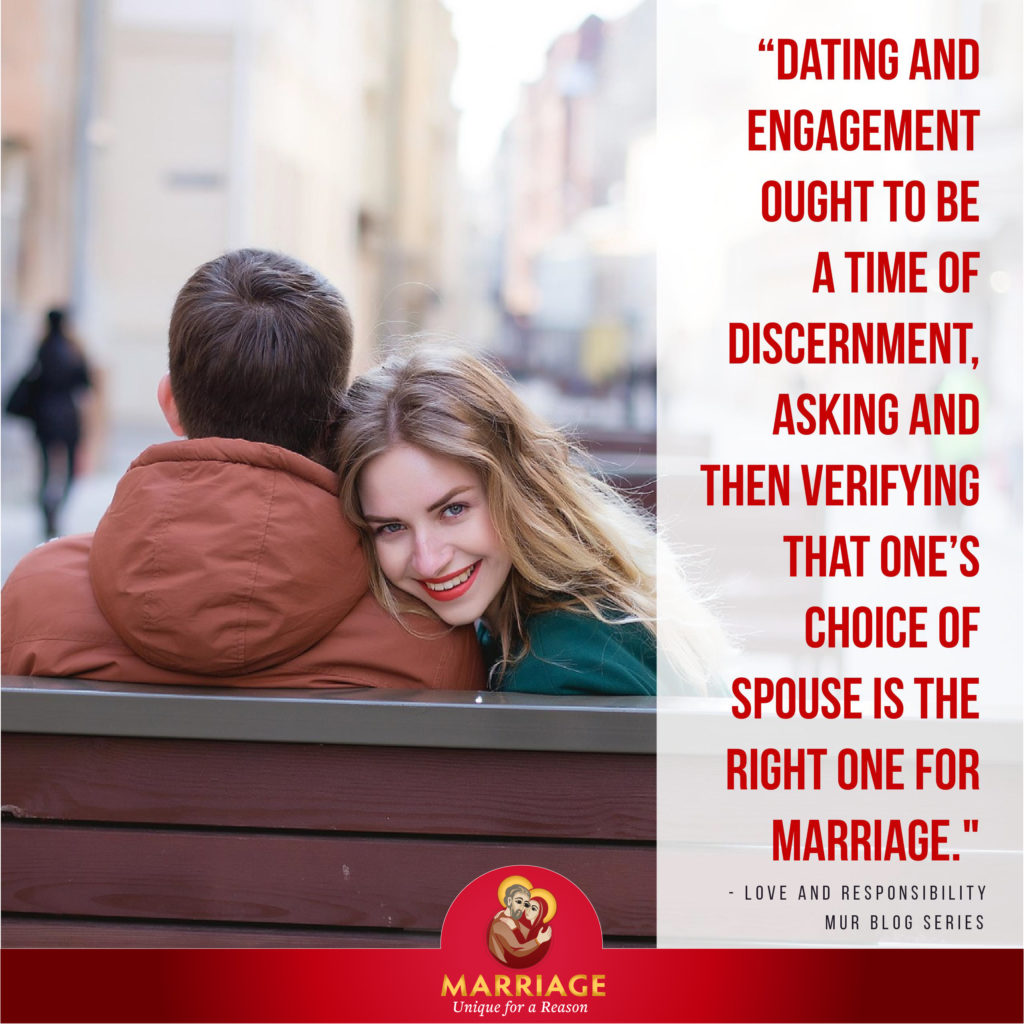 choosing oneself in another, and the other in oneself… in order not merely to live with another but to live by and for that other person, he must continually discover himself in the other and the other in himself.”[5] One’s spouse must be like another self.
choosing oneself in another, and the other in oneself… in order not merely to live with another but to live by and for that other person, he must continually discover himself in the other and the other in himself.”[5] One’s spouse must be like another self.
No one can really explain why one person chooses another, Wojtyla notes. Certainly sexual attraction plays a part, but only the choice of this person (not this body) can be considered valid for marriage. “True love is one in which we choose the person for the sake of the person,”[6] not for the sake of having sex, having children, or in order not to be alone. Whether one has chosen wisely will be discovered as time goes by. “Life will determine the value of a choice and the value and true magnitude of love.”[7]
Love and Marriage:
Love will be tested in marriage. Sexual interest may fade and fatigue set in; two people who once vowed to be all to one another may feel like strangers. “Nothing then remains except the value of the person, and the inner truth about the love of those concerned comes to light,” Wojtyla writes. “If their love is a true gift of self, so that they belong each to the other, it will not only survive but grow stronger, and sink deeper roots… only when love between human beings is put to the test can its true value be seen.”[8] If life was always easy, we would not really find out how real our love is.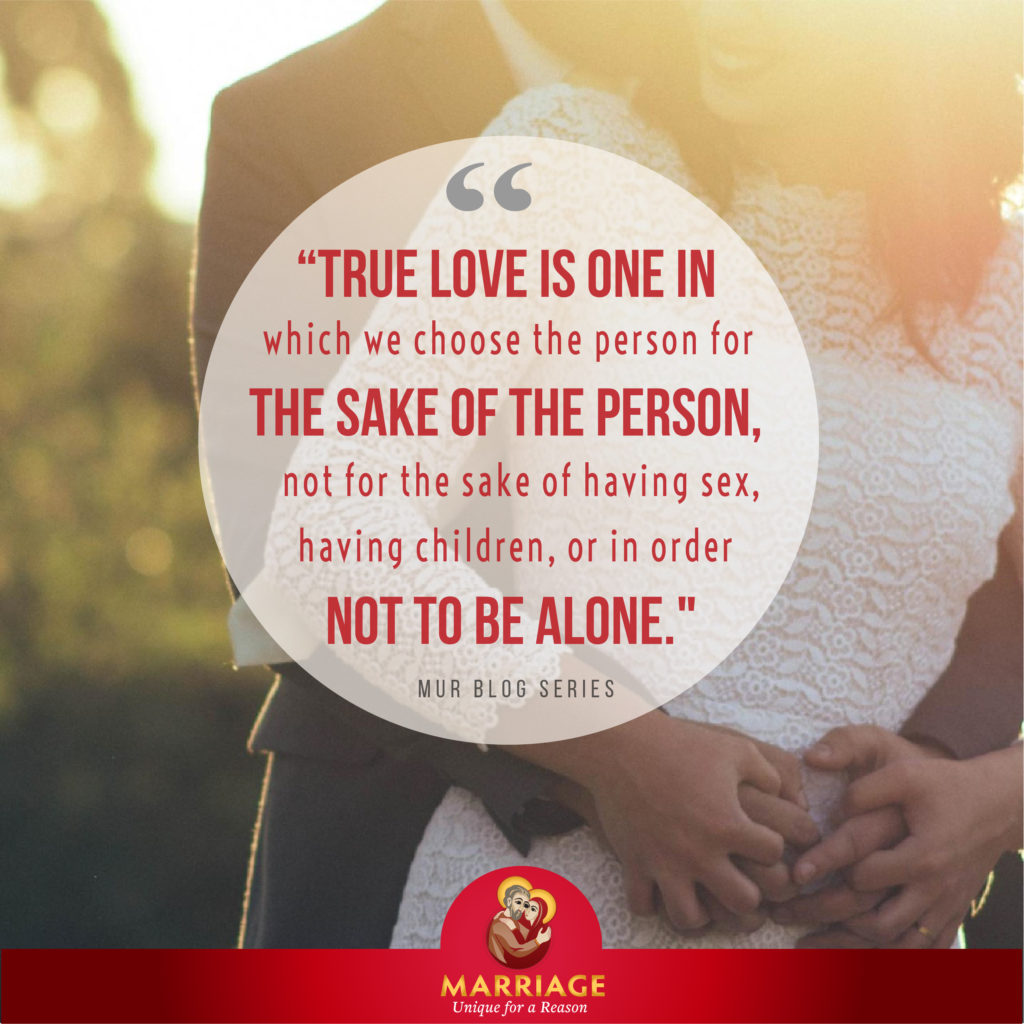
I see an elderly couple at Mass sometimes; the woman is in a wheelchair and she cannot speak. Her husband appears to take such good care of her, pulling her up to the front of the church, fixing her cardigan so that she won’t get cold, and smiling at people who come up to greet them. That is what true love looks like; it’s not easy, but it’s beautiful.
While emotions and desires change and fluctuate, a love which has matured within the subject frees itself from this anxiety by its choice of person.”[9] True love, based on the value of the person, “makes us feel emotional love for the person as he or she really is, not for the person of our imagination, but for the real person.”[10] At a certain level, this love is not dependent on the person’s virtues and lives on in spite of his or her faults. The strength of love shows itself most when the loved one fails in some way (makes mistakes, even sins). “One who truly loves does not then withdraw his love, but loves all the more, loves in full consciousness of the other’s shortcomings and faults, and without in the least approving of them. For the person as such never loses its essential value.”[11]
More on how this choice happens next time!
You can read ALL of MUR’s Love and Responsibility blog series in the link below: http://www.marriageuniqueforareason.org/category/love-and-responsibility/
[*] Not her real name.
[1] Wojtyla, Karol. Love and Responsibility (San Francisco: Ignatius Press, 1993), p. 130.
[2] Ibid, p. 130.
[3] Ibid, p. 131.
[4] Ibid, p. 131.
[5] Ibid, p. 131.
[6] Ibid, p. 134.
[7] Ibid, p. 134.
[8] Ibid, p. 134.
[9] Ibid, p. 134.
[10] Ibid, p. 135.
[11] Ibid, p. 135.
Archive
Integrating Love: Love and Responsibility Series (Post #11)
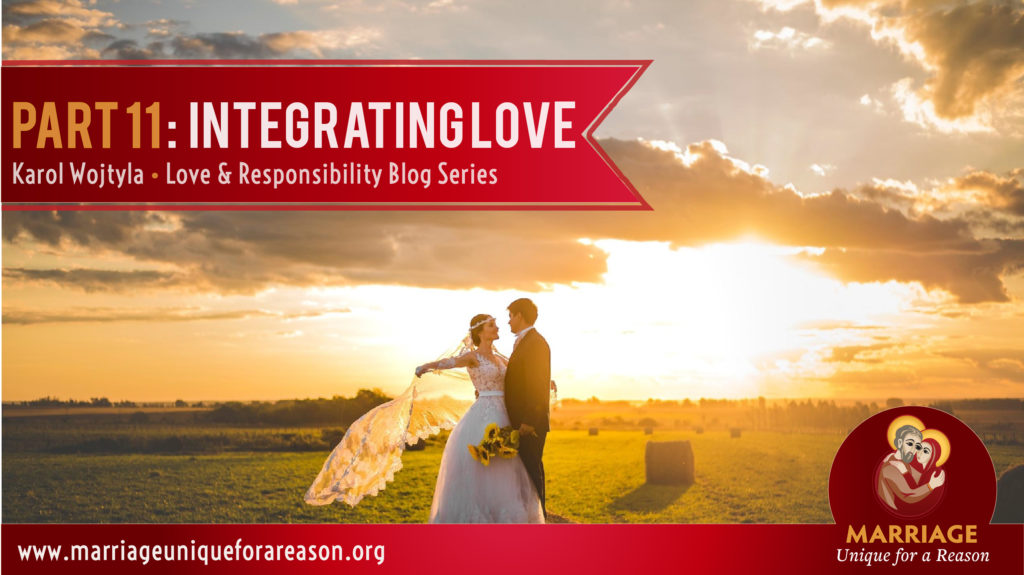
Integrating Love
In this section of Love and Responsibility, the future pope (St. John Paul II) identifies a challenge that is before a man and a woman who seek love: The Problem of Integrating Love.
So far, Wojtyla’s psychological analysis of love has been of sensual or sentimental reactions of a man for a woman and vice versa. In this section, he notes that all these reactions are “strictly individual”[1]—every person and every relationship is different. Love is always “unique and unreproducible,”[2] 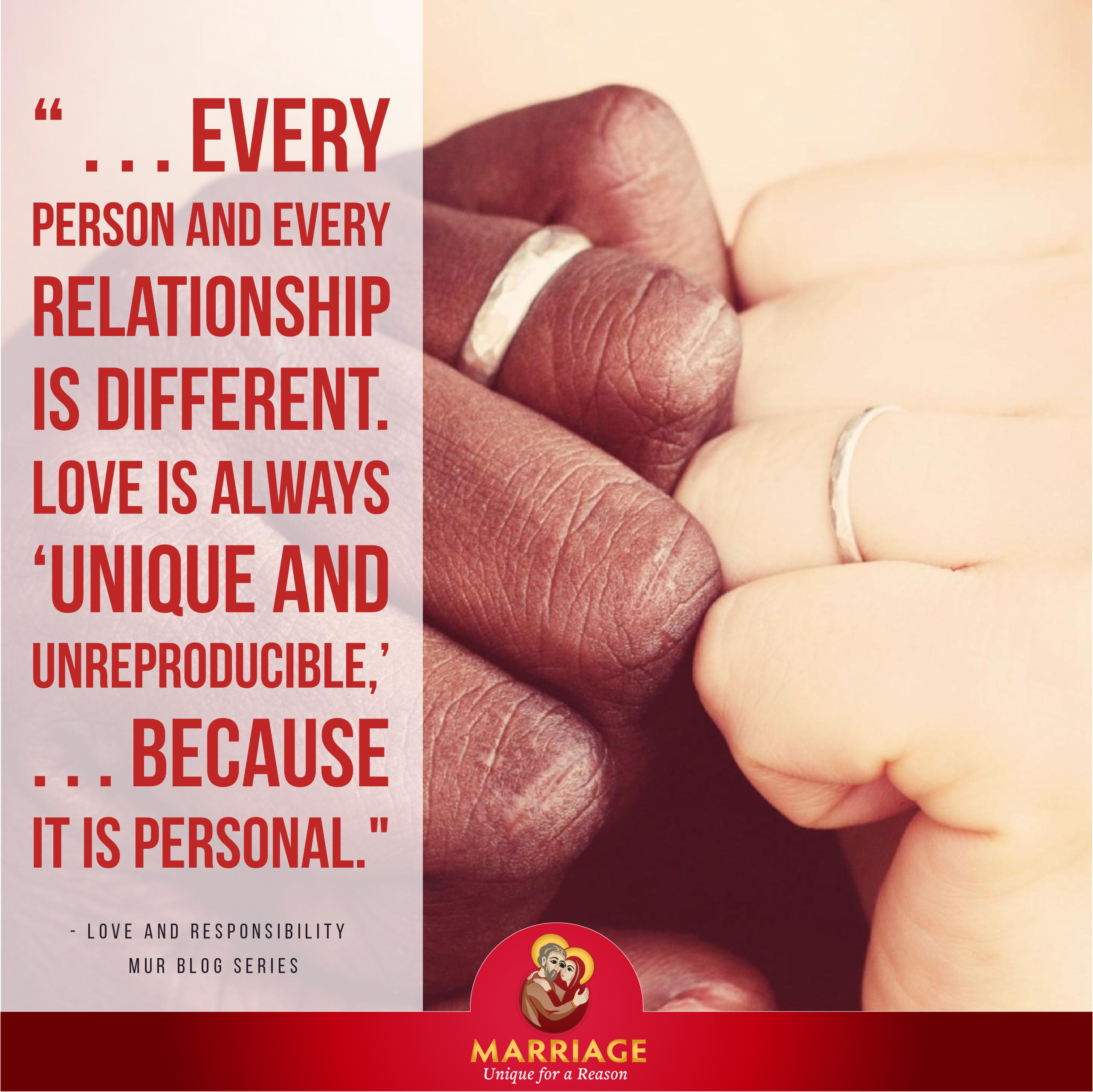 because it is personal. It has an inner dimension and an outer dimension; it is a drama of “great and absorbing importance”[3] in the lives of the two persons involved. Love between a man and a woman can make other experiences pale in comparison and may reveal parts of the self that the person didn’t even know were there. Love has great psychological power.
because it is personal. It has an inner dimension and an outer dimension; it is a drama of “great and absorbing importance”[3] in the lives of the two persons involved. Love between a man and a woman can make other experiences pale in comparison and may reveal parts of the self that the person didn’t even know were there. Love has great psychological power.
Truth and Freedom Integrate Love
Psychology itself, though, confirms that feelings are not enough to sustain love. Two characteristics of a person’s inner life that must enter into the relationship are truth and freedom. These help to 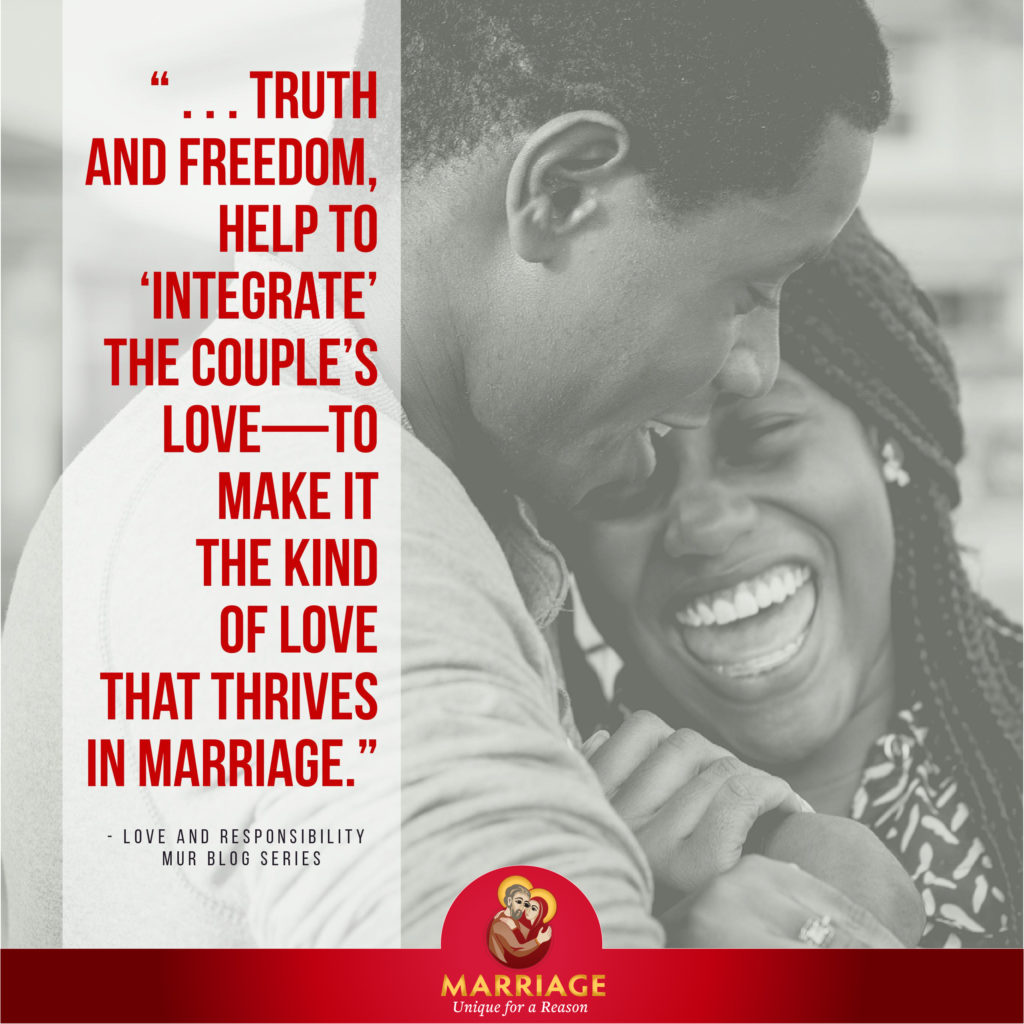 “integrate” the couple’s love—to make it the kind of love that thrives in marriage.
“integrate” the couple’s love—to make it the kind of love that thrives in marriage.
Wojtyla comes back, then, to the choice of the will based on knowledge of the other. “The value of the person is closely bound up with freedom, and freedom is a property of the will.”[5] As previously discussed, the commitment of the will to the other person’s good is decisive in true love. Love must be a free choice; one that is unconditional, and this kind of love cannot be promised without knowledge: “A really free commitment of the will is possible only on the basis of truth,” Wojtyla writes. The truth cannot be only the psychological truth (i.e. “We really feel in love with one another”) but also the objective truth that these two are good for one another. This objective, ethical side of love is Wojtyla’s next subject.
[1] Ibid, p. 115.
[2] Wojtyla, Karol. Love and Responsibility (San Francisco: Ignatius Press, 1993), p. 114.
[3] Ibid, p. 114.
[4] Ibid, p. 116.
[5] Ibid, p. 117.
Archive
Sensuality: Love and Responsibility Series (Post #9)
Sensuality as Impression:
In his section on sensuality, Wojtyla looks at what happens when a man and a woman “make an impression” on each other. With this phrase, we are saying more than that Harry and Sally met; We are saying that this meeting left an impression. Harry walked away with a mental picture of what Sally looked like; Sally left with a memory of what Harry sounded like (for example). The impression was spontaneous—it happened to them, they didn’t do it to themselves—but it linked up with an intellectual acknowledgement, such as, “He/she is attractive; maybe we could get together.”
The immediate reaction is what Wojtyla calls sensuality. “Sensuality is not just a matter of male x becoming aware of female y through his senses, or vice versa. Sensuality always implies experiencing a particular value bound up with this sensory awareness. Specifically we are concerned with a sexual value, connected above all with the body of a person of the other sex.”[1] Sensuality by itself, Wojtyla says, has a “consumer orientation,”[i] being aimed at a body and not a person; in this way it can interfere with noticing and knowing the person as they truly are.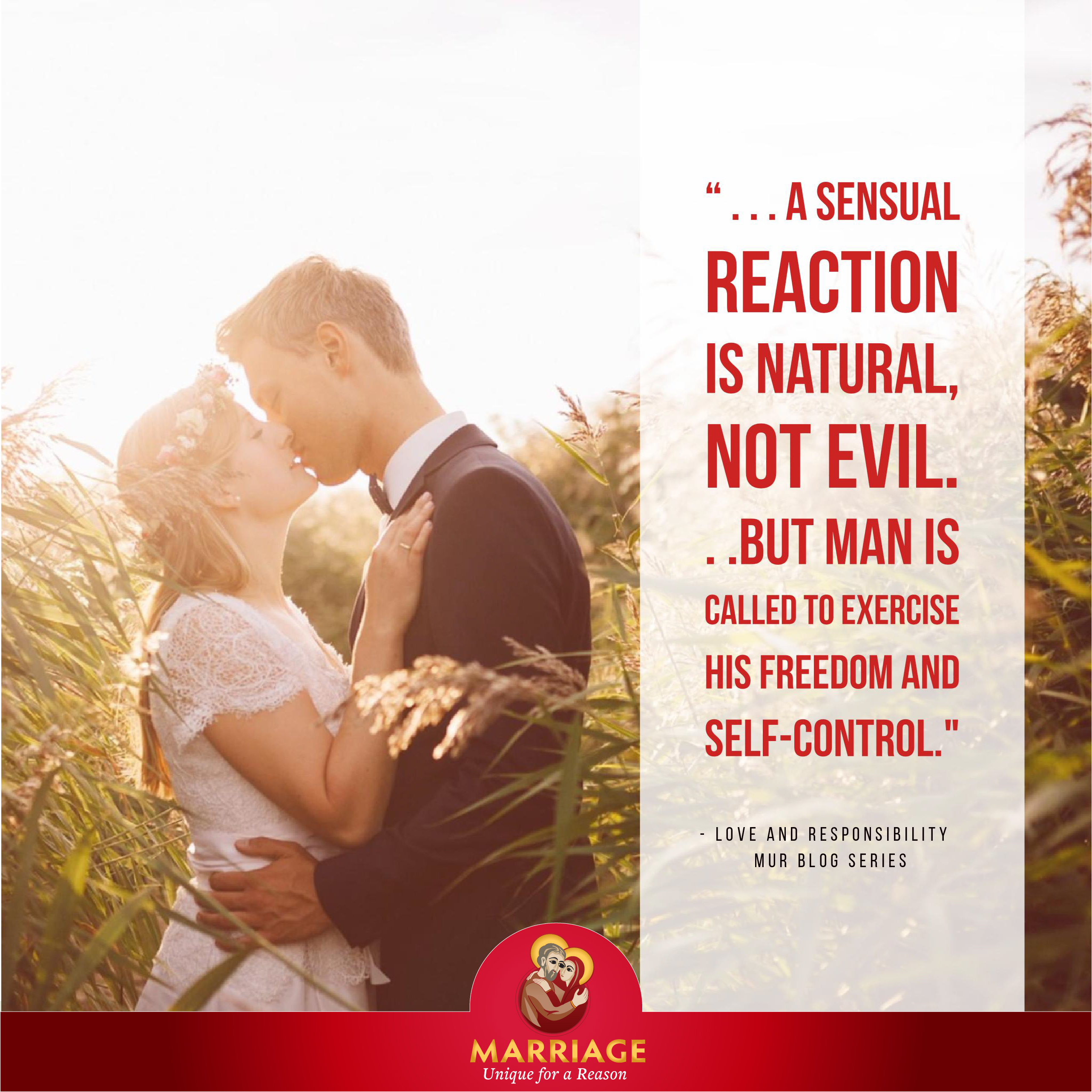
Sensual Reaction is Natural:
Wojtyla is quick to point out that a sensual reaction is natural, not evil; it is a “reflex.”[ii] A healthy body reacts with sensuality because of the biological facts of human existence (man + woman = baby) and it is in and through the body that these facts are experienced. Sexual attraction to another person reaches consciousness “where the impression is accompanied by an emotion experienced not only mentally but bodily. Sensuality is connected with the stirrings of the body, especially in its so-called erogenous zones.”[iii] This kind of spontaneous bodily reaction is particularly strong in men. Wojtyla notes that a man’s bodily reactions “would give man all the guidance he needs in his sexual life”[iv] if he were only an animal, driven by instinct to another animal. But man is called to exercise his freedom and self-control.
The sensual reactions of the body can pose a threat to true love when they “devalue the person”[v] by seeing the other as an object. This is why the  conscience is often stirred by sensual reactions—a man (or a woman) knows that this reaction does not do full justice to the person in front of them. They may be embarrassed by it. But sensuality can be understood as the “raw material” for love, when it is integrated into a full human relationship.
conscience is often stirred by sensual reactions—a man (or a woman) knows that this reaction does not do full justice to the person in front of them. They may be embarrassed by it. But sensuality can be understood as the “raw material” for love, when it is integrated into a full human relationship.
Wojtyla notes that sensuality, since it is focused only on a body, is notoriously fickle. It turns easily from one person to the next. A man who goes to a bar and “checks out” every woman who walks in the door is a prime example of someone seemingly ruled by sensuality. Wojtyla also notes that a person may  react sensually to a body that is not present (consider pornography) and that sensuality may “insinuate itself into [a] situation ‘uninvited,’”[vi] such as when an artist is painting a nude model (and has no intention of using her sexually). These reactions make life complicated!
react sensually to a body that is not present (consider pornography) and that sensuality may “insinuate itself into [a] situation ‘uninvited,’”[vi] such as when an artist is painting a nude model (and has no intention of using her sexually). These reactions make life complicated!
Lest a person who is naturally more sensual (reacting swiftly or strongly to the other sex) be led to despair, Wojtyla notes at the end of this section that, “An exuberant and ready roused sensuality is the stuff from which a rich—if difficult—personal life may be made.”[vii] An ardent temperament can lead to an ardent love.
[1] Wojtyla, Karol. Love and Responsibility (San Francisco: Ignatius Press, 1993), p. 105.
[i] Ibid, p. 105.
[ii] Ibid, p. 106.
[iii] Ibid, p. 107.
[iv] Ibid, p. 107.
[v] Ibid, p. 107.
[vi] Ibid, p. 109.
[vii] Ibid, p. 109.
Archive
Marital Love: Love and Responsibility Series (Post #8)
Betrothed Love:
In this section of Love and Responsibility, Wojtyla looks specifically at the type of love that a husband and wife share, and he calls this “betrothed love.” The phrase in English that better conveys what Wojtyla means is “marital love,” since he means the love in which a man and woman give themselves fully to one another.
Wojtyla reminds us that we must possess ourselves before we can give ourselves. Self-gift is not about passively becoming what someone else wants us to be. Have you seen the movie 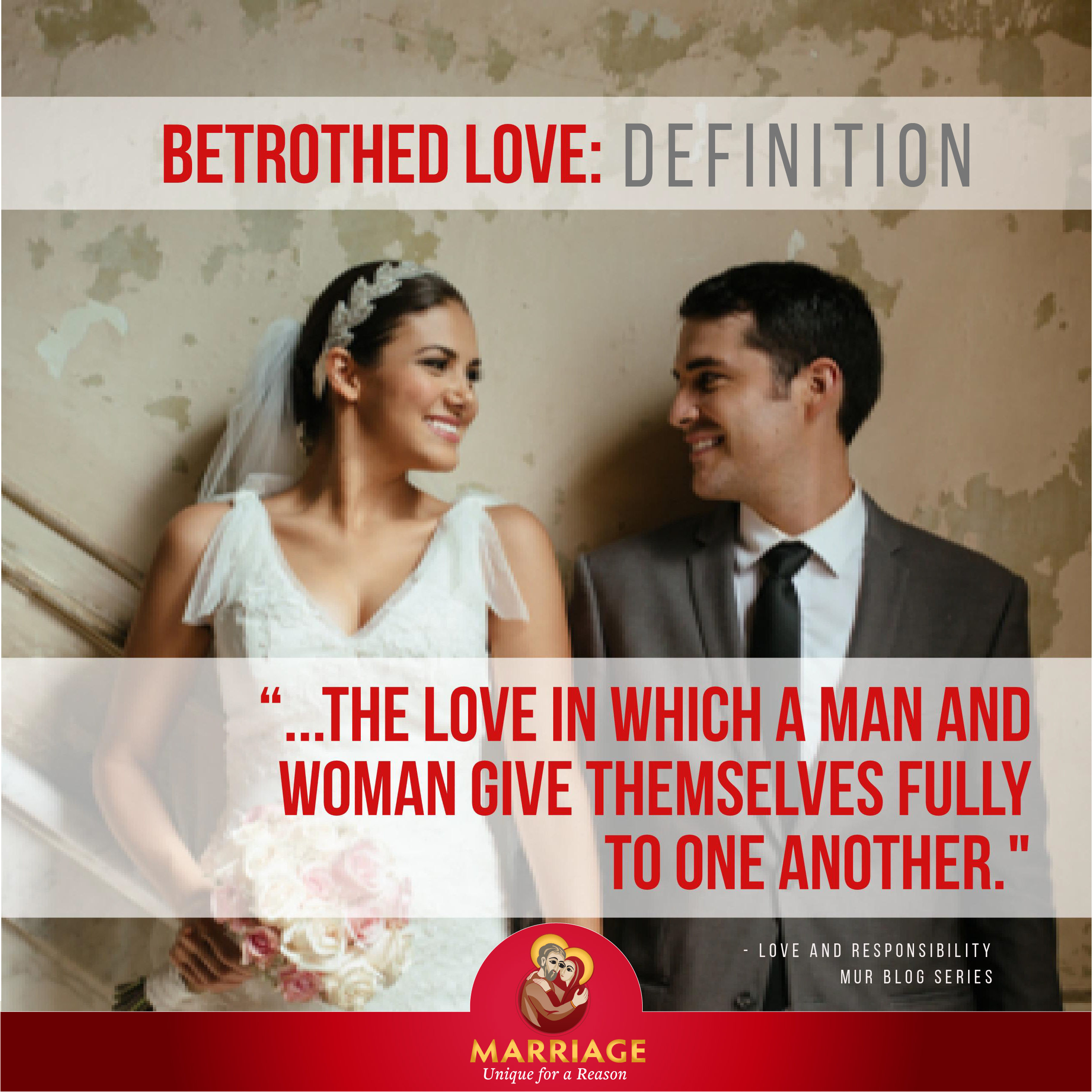 Runaway Bride (1999)? The main character (Maggie) always adjusted her likes and dislikes according to what her boyfriend or fiancé liked. She wanted to be loved, so she changed herself to match whatever the man she was with liked in a woman. With the hippie, she became a hippie; with the athletic guy, she became a sports fan. After this habit was pointed out to her, Maggie realized that she didn’t know herself.
Runaway Bride (1999)? The main character (Maggie) always adjusted her likes and dislikes according to what her boyfriend or fiancé liked. She wanted to be loved, so she changed herself to match whatever the man she was with liked in a woman. With the hippie, she became a hippie; with the athletic guy, she became a sports fan. After this habit was pointed out to her, Maggie realized that she didn’t know herself.
Most of us can probably relate to this impulse at some level: We fudge our favorite book so that we sound smart, or nod our head when our crush talks about a band we’ve never heard of… if that kind of thing becomes a habit, we might reach a point where we don’t “possess” ourselves and cannot find real love. This is perhaps more common for women than men.
Marriage is to Give
Wojtyla points out that, psychologically speaking, it is usually the woman who feels that her role in marriage is to give. However, objectively (or ontologically) speaking, both spouses must give themselves to one another, and not just sexually. “Giving oneself only sexually, without the full gift of the person,”[1] is just a form of use, as previously discussed. Husband and wife give themselves to one another even through the mundane activities of daily life. 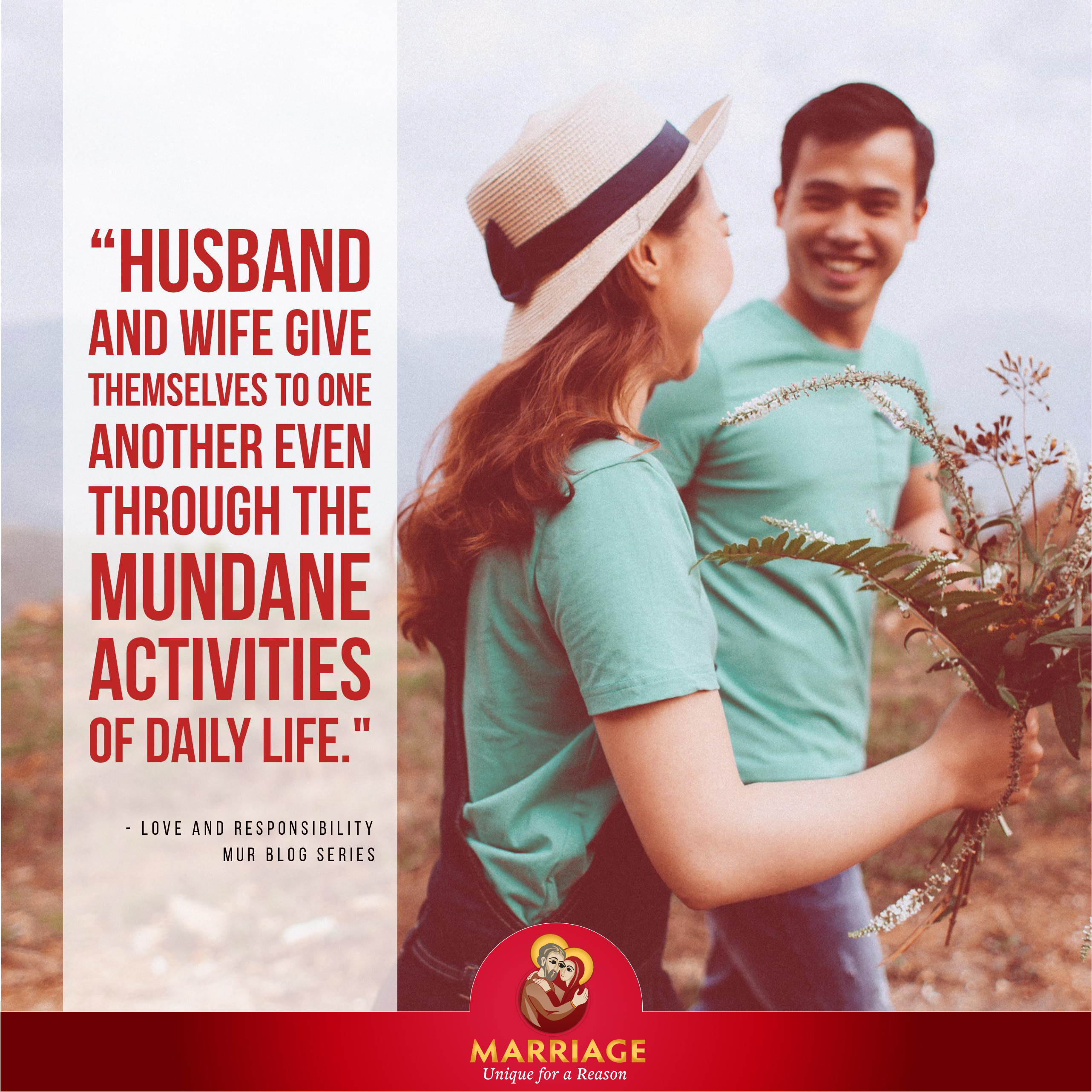
At the risk of being too movie-heavy in this post, the movie Fireproof (2008), while one of the cheesiest movies ever, does a great job communicating this truth about marriage. Once the husband (Caleb) begins really giving himself to his wife by making her coffee, buying her flowers, and considering her needs before his own (possibly for the first time in their entire marriage), the relationship is transformed. Caleb comes to understand that love is a choice; He recognizes that he has been selfish and that he has not acted with goodwill and friendship.
The Person and Love:
Wojtyla concludes with the note that marital love is not some isolated kind of love, different from every other kind. “Betrothed love, though of its nature it differs from all the forms of love previously analyzed, can nevertheless not develop in isolation from 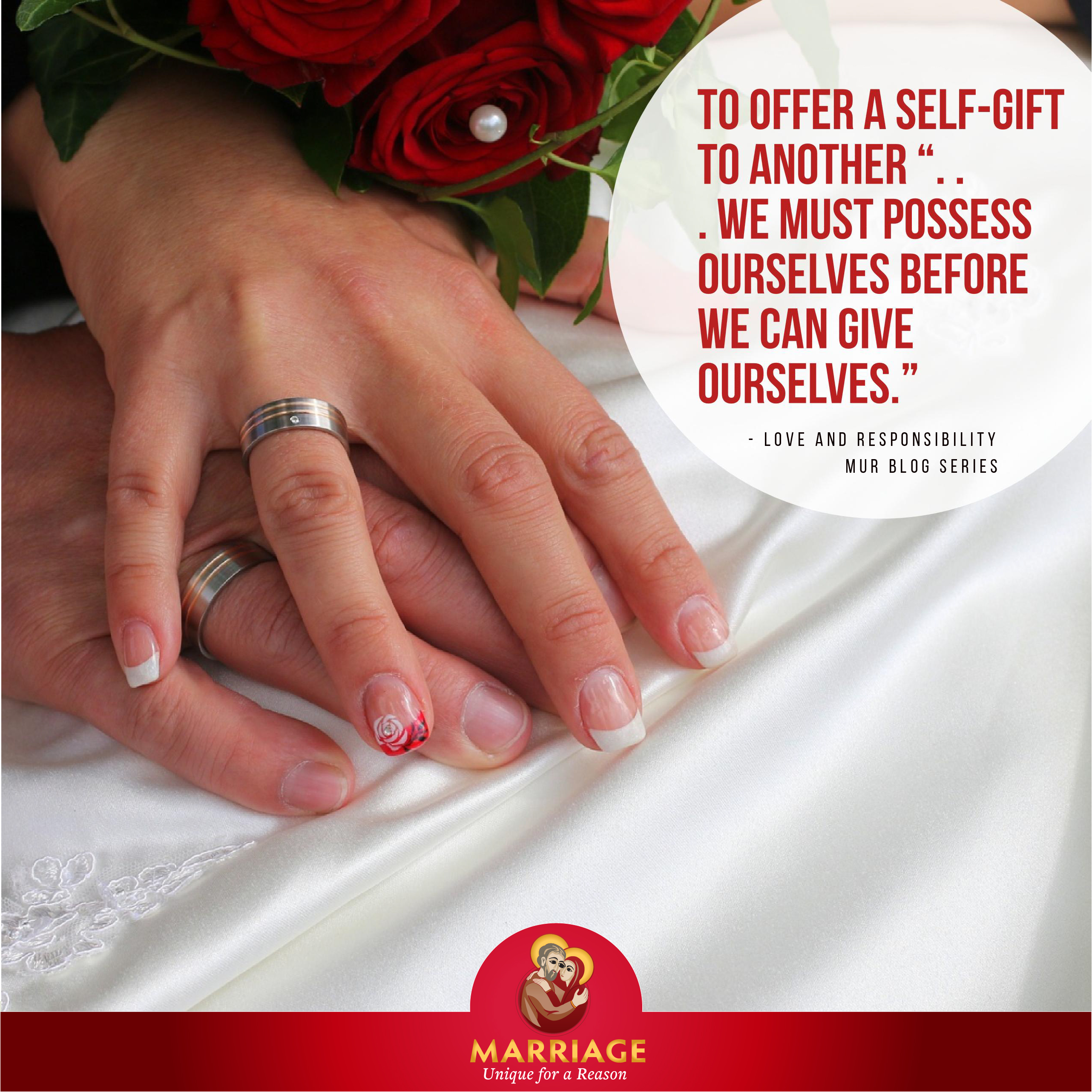 them. In particular, it is essential that Husband and wife give themselves to one another even through the mundane activities of daily life..”[2]
them. In particular, it is essential that Husband and wife give themselves to one another even through the mundane activities of daily life..”[2]
Thus concludes the section on “The Person and Love.” We have looked at attraction, desire, goodwill, reciprocity, friendship, and betrothed love as experiences of the person. In the next section, Wojtyla goes into a psychological analysis of love. Stay tuned!
[1] Ibid, p. 99.
[2] Ibid, p. 100.
Archive
Use v. Love: Love and Responsibility Series (Post #3)
Between ‘Use’ and ‘Love’:
The first distinction that Wojtyla makes in Love and Responsibility, between “use” and “love,” is one that we understand intuitively. No one wants to be used; It’s a terrible feeling! We commonly learn that pretty early on in life—maybe at the 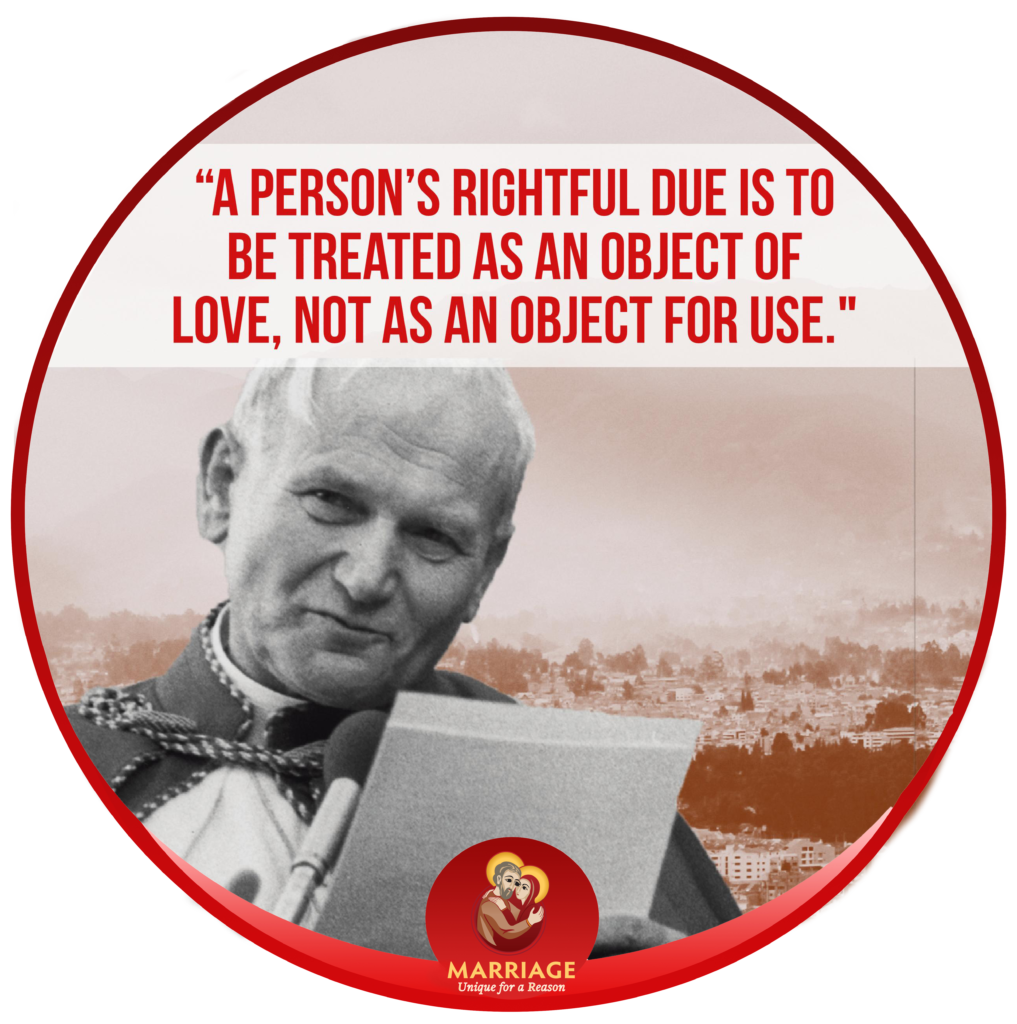 playground, or at a friend’s house—when we realize that the other kid only wants to play with us because we have the latest gadget that their parents won’t get for them. That’s such a small example, but these are real lessons in whether another person likes us for ourselves or only likes us for what we do for them.
playground, or at a friend’s house—when we realize that the other kid only wants to play with us because we have the latest gadget that their parents won’t get for them. That’s such a small example, but these are real lessons in whether another person likes us for ourselves or only likes us for what we do for them.
We all know that people can be used by others for sexual pleasure. This is not okay, even if the person consents to being used (such as in prostitution). A person has an inherent dignity that should rebel at even the suggestion that he or she should allow someone else to “use” them. But early childhood wounds, insecurity, or other factors may dull a person’s sense of how he or she deserves to be treated. In this section of Love and Responsibility, Wojtyla explains why using another person is incompatible with their dignity.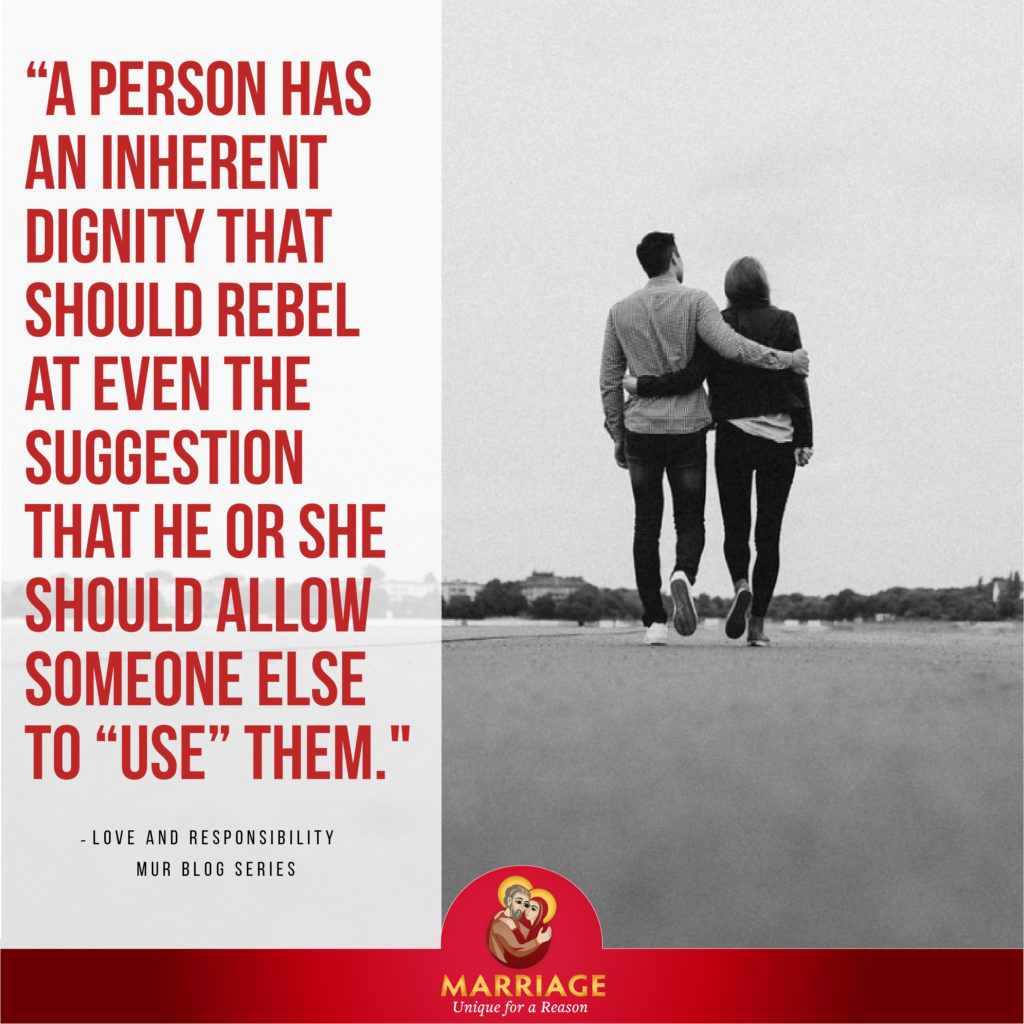
“To use means to employ some object of action as a means to an end—the specific end which the subject has in view.”[1] For example, I use a pencil to write on my calendar. The pencil is a means to the end of writing. My aim is to put something on my schedule; the pencil is just a means to accomplish that. In fact, a pen would do just as well. Chances are, I just picked up the closest tool, the closest object, that would do the job.
Karol Wojtyla’s Personalistic Norm:
When you think of it that way, it’s easy to see that a person shouldn’t be treated the same way as a pencil. Things are interchangeable, but persons aren’t. Wojtyla notes, “The sexual relationship presents more opportunities than most other activities for treating a person—sometimes even without realizing it—as an object of use.”[2] He calls us to be on guard against this tendency, which is in all of us to some extent.
There are lots of reasons why we may be tempted to treat another person as an object—as a means to our own pleasure or happiness. We may be more focused on our own feelings of loneliness or desire than on the actual person in front of us. But part of love is “a readiness to subordinate oneself” to the value of the person.[3] In other words, love means treating someone the way they deserve to be treated. If you love a person, you don’t want to use them—even if they were to mistakenly agree to be used.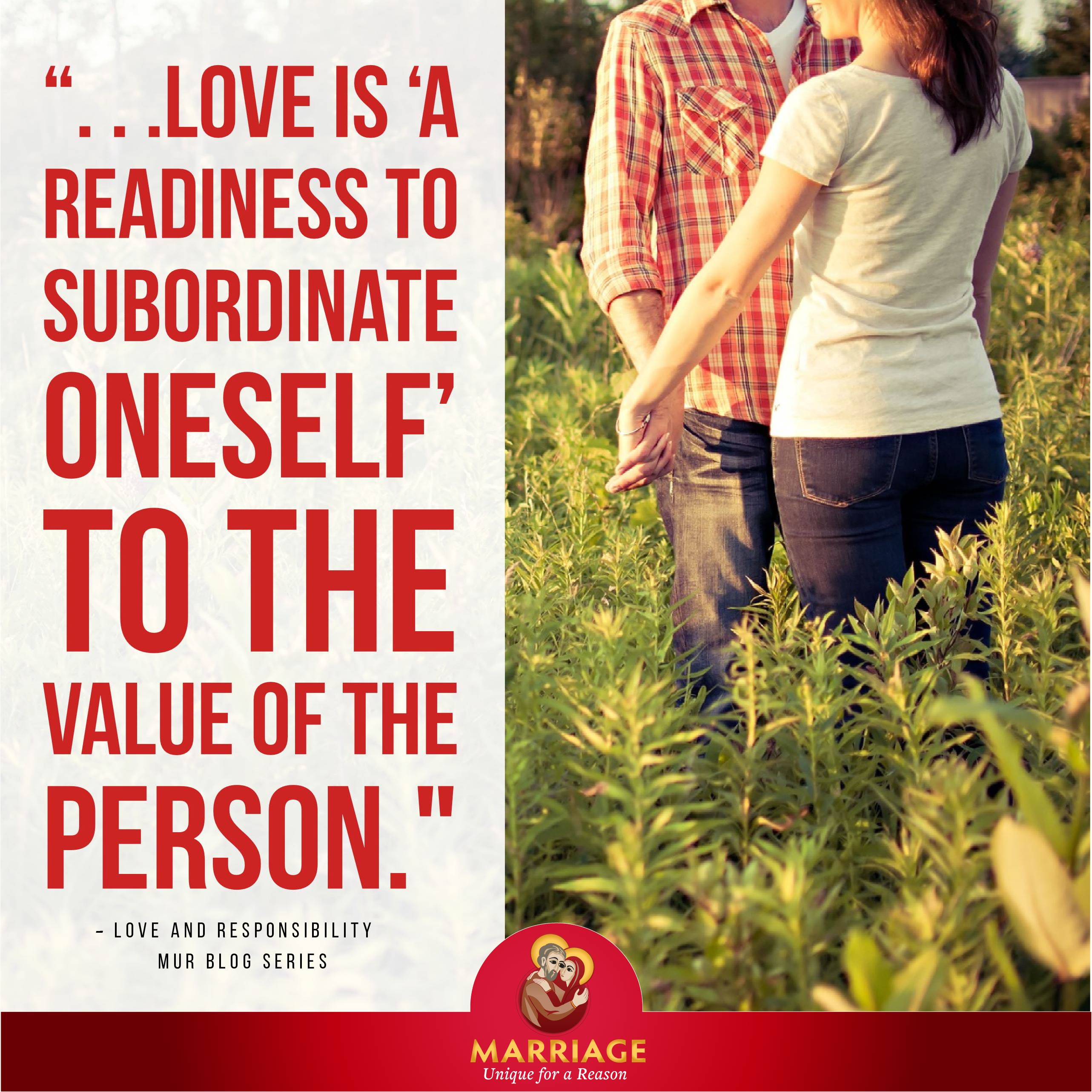
So we come to what Wojtyla terms the “personalistic norm”—the way persons ought to be treated: “the person is a good towards which the only proper and adequate attitude is love.”[4] The personalistic norm is essentially the same as God’s commandment to love. You could even think of it as the Golden Rule: treat others the way you want to be treated. But again, sometimes we mistakenly forget that we are children of God and should be treated with love and respect—sometimes we settle for being treated “okay,” which means we might think treating others just “okay” is fine. Instead, it might help to think about a young child whom you love—whether yours, or one in your family—and how you want them to be treated. This can be clarifying, kind of like when you ask a teenage boy how his little sister should be treated on a date. We often are more protective of others’ hearts than our own.
To conclude: Treating the person with love (and not using them) is a step in fulfilling God’s call to love our neighbor.
[1] Wojtyla, Karol. Love and Responsibility (San Francisco: Ignatius Press, 1993), p. 25.
[2] Ibid, p. 30.
[3] Ibid, p. 31.
[4] Ibid, p. 41.
Archive
Interracial Marriage Comparison
Continuing to debunk the erroneous comparison of marriage redefinition to interracial marriage, Ryan Anderson and Gloria Purvis talk about what marriage is.
This is the question that has been continuously ignored or set aside in the “marriage debate,” even before the Supreme Court. The state’s version of marriage is necessarily a weak one, and open to manipulation and more changes, because it appears to be solely based on the emotional desires of adults.
Interracial marriage is simply marriage. It is not any different from the definition of marriage that held steady from the ancients until the modern era of one man and one woman, for life, who (often) have children together. The redefinition of marriage in the law to include same-sex couples is completely different; two persons of the same sex, who– by definition, not accident– cannot unite completely or conceive children with one another in a sexual act.
Gloria talks about the distinction between actions and being. The rhetoric today is that a person “is” a “gay man”—but this is an entirely new category in history and the construction of an identity that is based on a feeling or attraction [which can change] and/or actions related to it, not the being or the core of the person. The person remains a man or a woman, whose body is objectively ordered, sexually, toward the other.
Archive
Sexual Difference Matters: Made for Life Series
We finish this series on Made for Life with a clip of Katie and Pete talking about the way that marriage provides the “perfect” setting to raise a child. It takes a man and a woman to bring a new human being into the world. Two men or two women simply cannot do this. So if sexual difference is the basic necessity for conceiving a child, then it makes sense that sexual difference would also be important for raising that child. A mother and a father bring balance and ensure that children always have one person similar to and one persondifferent from them to look up to.
A child’s “first right” is to “be born in a real family,” that is, to be born to his or her own father and mother, bonded in marriage.[i] Protecting this right is a matter of social justice. As the bishops have taught, “To promote and protect marriage as the union of one man and one woman is itself a matter of justice. In fact, it would be a grave injustice if the state ignored the unique and proper place of husbands and wives, the place of mothers and fathers, and especially the rights of children, who deserve from society clear guidance as they grow to sexual maturity.”[ii]
It is sometimes claimed that what really matters for a child is the presence of any two loving, committed adults, regardless of their sex/gender. But there are major problems with this assertion. First, two men or two women are physically incapable of having a child together. Nothing they do can change this fact. Instead, two people of the same sex must either attempt to adopt a child or contract with a “third party” egg or sperm donor who contributes one-half of the child’s genetic material. This means that placing a child in the care of two men or two women deliberately separates that child from his or her father or mother in every single case. Then, those children are further denied the benefit of witnessing a healthy relationship between a father and mother and the experience of the parental love of either a man or a woman. Children deserve better.
Discussion Questions
- Why do you think the Church teaches that a child has a right to be born into a family?
- How does having a mother and father give the child the balance he or she needs?
- What other topics would you like to explore with Marriage Unique for a Reason? Leave a comment and let us know!
[i] Compendium of the Social Doctrine of the Church, no. 244.
[ii] Marriage: Love and Life in the Divine Plan, 22. The needs and rights of the child should be of fundamental concern for every society and community, as is acknowledged in “the principle, recognized also in the United Nations Convention on the Rights of the Child, that the best interests of the child, as the weaker and more vulnerable party, are to be the paramount consideration in every case.” CDF, Considerations Regarding Proposals to Give Legal Recognition to Unions Between Homosexual Persons (2003), no. 7, www.vatican.va/roman_curia/ congregations/cfaith/documents/rc_con_cfaith_doc_20030731_homosexual-unions_en.html.
Archive
Mothers and Fathers are Different: Made for Life Series
This week’s clip begins with Katie and Pete talking about how they play differently with their kids, and moves to Pete talking about society’s obligation to support that which is best for children.
That mothers and fathers are different is a common sense and intuitive statement. It does not mean that “All moms do X” or “All dads do Y” but rather that mothers and fathers, even when they do the exact same thing, do not do it the same way. Men and women just do things differently.
Why is this important and beneficial for children? Sociologically, we don’t know, we only know that it appears to be the case. Philosophically, we can understand it because we know ourselves to be one sex or the other, and therefore seeing both ways of being human every day informs our self-understanding as well as an understanding that there is always another way of being. And theologically, we can see that if sexually-differentiated humanity is really “the image of God,” then our image of God, our idea of who God is and how God loves us, will be incomplete without seeing the love of a man and a woman lived out before us.
And if we know that it’s important for kids to have a mother and a father, and that even if we don’t know why, children consistently do better in that environment, shouldn’t we promote and defend it?
Discussion Questions
- What are practical ways that you can promote and defend marriage today?
- What are examples from your own family of how masculinity and femininity is displayed and honored in a day-to-day way?
Archive
What Is Marriage All About?
The final section we are going to discuss from Made for Each Other has to do with what is traditionally called the two “ends” (or purposes, reasons for existing) of marriage. The Church teaches that because marriage is the total gift of one spouse’s life to the other, it entails both the gift of love and the gift of children. Marriage is the gift for life and the gift of life. It’s unique and irreplaceable—the fundamental institution for life.
The Church affirms that the love of husband and wife is a great good in and of itself, even if they do not receive the gift of a child. Human marriage is a foreshadowing of the marriage between Christ and his Church and sacramental marriage participates in and shows forth this love (see Eph 5:28-33).
Marriage lived in truth is an indispensable model of communion for the world and an affirmation that life is good. The love of husband and wife reminds us all that no one is an isolated individual, that we need one another at the most fundamental level. This love is meant to be the context for welcoming, forming, and educating new life. This is why marriage, as a personal relationship, has always been recognized to have great, public significance. The love of spouses, the responsibilities of mothers and fathers, and the rights of children—all are tied to the unique truth of marriage and its protection and promotion.
The Church will never waver in her teaching that marriage is the lifelong union of a woman and a man, open to life. From the beginning, man and woman are made for each other. There is nothing else like it.
Discussion questions:
- How is marriage the “gift for life” and the “gift of life”?
- The public proposal to “redefine” marriage to include persons of the same sex is fairly recent. How is it connected to a larger confusion around the meaning of the person and sex?
- How is this meaning inseparable from the truth of marriage as the union of one man and one woman?
***
For this reason a man shall leave his father and mother and be joined to his wife, and the two shall become one flesh. (Mt 19:5)
Archive
What Are These Differences?
In this section of Made for Each Other, Josh and Carrie explore what sexual difference may look like in a given couple. Men and women are, as Carrie puts it, “different in ways that will always matter.” Biology is important, but the body and the person are not reducible to biology. Sexual difference involves the whole person, body and soul.
The body reveals the person. We’re not souls trapped in bodies. We’re “body-persons.” We don’t just have a body. We are our bodies. (We even have words for people who are without one or the other—a corpse is a body that is missing a soul; a ghost is (perhaps) a soul missing a body.) The body of a man and the body of a woman are distinct, personal realities. In addition, as Pope St. John Paul II taught, these bodies have a “spousal meaning.”[i] The body, in its masculinity or femininity, reveals that we are persons who are made to be a gift to others and to be received as a gift by others.
Every human person shares the same nature (human) and the same dignity, made in the image of God. Our sexual identity as a man or a woman is the way in which that humanity is manifested. This identity is meant to be acknowledged and accepted as a gift from God.[ii] It has significance for all the various ways we relate to others: we are a daughter or a son, a sister or a brother, a mother or a father.
While some play down the reality of sexual difference or limit it to the differences between female and male anatomy, sciences such as neurobiology, evolutionary psychology, endocrinology, histology, and reproductive physiology—to name a few—point to the intricate, unique, and complementary physiologies of women and men. We may have conversations differently; take risks differently; form and process relationships differently; respond to threats differently. These differences do not imply that one sex is superior to the other. Men and women are just different. Admitting this does not diminish either sex but serves to enhance the possibility of their unity in love.
Of course, men and women differ among themselves, as well as differing from each other. Sex differences in each and every trait need not be present in each and every individual woman or man. But the way a trait is lived out will always be distinct, whichever person, man or woman, is exhibiting it. For example, the way that St. Joan of Arc was a soldier was not the same as a man’s way.
Our gender, which can be distinguished but not separated from our sex,[1] is a fundamental “given” in our lives. Male and female are two different ways of being human, body and soul.
Discussion questions:
- What does it mean to say that “the body reveals the person”?
- How do equality and difference go together when speaking of man and woman? How does complementarity depend upon difference?
[1] See Amoris Laetitia, no. 56.
[i] See TOB, 13:1–16:2. See also Pope John Paul II’s Familiaris Consortio, no. 37, and Veritatis Splendor, no. 15.
[ii] See CCC, nos. 2332-2333.
Archive
Sexual Difference Does Not Compete, It Complements
In our second clip from Made for Each Other, Carrie ends with the comment, “Our sexual difference doesn’t compete; it complements.” Sexual unity and the coming-to-be of babies depend on the difference between man and woman. The husband gives his whole self (body, mind, heart, soul) to his wife; the wife gives her whole self to her husband. This happens in a particularly clear and dramatic way when the gift of the body is offered in marital intercourse. The spouses give themselves and receive each other in and through their difference. As Josh says, “every natural process of the body” can be done by oneself—“everything but making love and having children,” which depends upon the other person being different. Sexual difference is the avenue towards real union, a union that is also open to life.
Sexual difference concerns the whole person, as Carrie points out. Only through this difference can a man and a woman give themselves fully and love each other as spouses. This isn’t unjust discrimination; it’s an actual distinction, a matter of reality. Sexual intercourse in marriage is a way of communicating, it is a language spoken face-to-face. Part of the essential grammar of this language is sexual difference. Without it, marriage can’t be spoken of.[i]
Men and women are equal and different. Difference is a great and necessary good. “It’s constructive,” as Josh says. Sexual difference is what enables a man and a woman to form a unique bond for life, a union that is deeper than friendship and lasts until death. A husband gives to his wife what only a husband can give. Likewise, a wife gives to her husband what only a wife can give. And together, they give the world new life!
Discussion questions:
- Do you think sexual difference is understood and appreciated today? Why or why not?
- How can we help others reflect on the importance of sexual difference and complementarity?
[i] This is also why sex outside of marriage doesn’t make any sense. Sex itself speaks a language of total commitment and gift—faithful and indissoluble love. That’s the language of marriage. Sex outside of marriage always says something that is untrue. It’s pretending. Real love depends on truth, and truth depends on love (see Pope Benedict XVI, Encyclical Caritas in Veritate [Washington, DC: USCCB, 2009], nos. 1-9).
Archive
Made “For Each Other”
In this segment of the video, Josh and Carrie discuss the way that marriage is not like being roommates who live together, but separately. Man and woman are made for each other in a way that is absolutely unique. We see this through their sexual difference, even if we just look to the human body as male or female. A man’s body does not make sense by itself, nor does a woman’s; only together is it possible to get the whole picture of humanity. At a deeper level, as Josh says in the video, there is also a longing of the one for the other. There are always and only two ways of being human[1]: we cannot be the other, so we want to be with the other.
We are made for union and communion, to be in relation with others.[i] In Genesis, God says, “It is not good for the man to be alone” (Gn 2:18). God’s solution to man’s isolation is not to create another identical man. Rather, He creates a woman from the man’s side and gives the two to each other in the first marriage. “For this reason, a man shall leave his father and mother and be joined to his wife, and the two shall become one flesh” (Mt 19:5; cf. Gn 2:24).
The two become one flesh in the physical act of sexual intercourse, in which the bodies of the man and woman cooperate in an act which may bring about the procreation of another human being. As Eve says, “I have produced a male child with the help of the LORD”(Gn 4:1). There is only one “combination” of human bodies that can produce new life: a man and a woman. If you accept the idea that human life has special value, then you should also accept that the (one and only) natural action that can bring this life into existence is, by that fact, unique in its power and importance to the world.
The truth of the human person, created male and female, and the truth of what marriage is, are not only concerns of religion or religious people—they are truths that affect everyone.
Discussion question:
- Why is it important to society that marriage be based on sexual difference?
- Why is the fact of our being created male and female not simply a tool for the survival of the species?
[1] Even in those rare cases of atypical genetic or physical development, the fundamental question is whether the person is male or female. There are only “X” and “Y” chromosomes, there is no “other” sex. In such cases, we rely on natural science that can help determine biological sex. This knowledge will help the person to understand his or her sexual identity.
[i] See CCC, nos. 45, 371-372, 1603-1604, and 1877-1879.
Archive
Made for Each Other: Short Segments for Study
Introduction
But God did not create man a solitary being. From the beginning “male and female he created them” (Gn 1:27). This partnership of man and woman constitutes the first form of communion between persons.
–Second Vatican Council, Pastoral Constitution Gaudium et Spes (1965), no. 12[i]
What is marriage?
The question of what marriage is has been largely ignored in debates about who can get married. Before asking who can get married, one should ask what “marriage” is. What is this relationship that two (or more) people want the state to recognize, and why should society care about it?
Let’s see what definitions are out there and how they measure up to what we all kinda-sorta-in-our-bones know about what marriage is.
Google: the legally or formally recognized union of a man and a woman (or, in some jurisdictions, two people of the same sex) as partners in a relationship.
“Union… as partners in a relationship.” Well, what kind of relationship? What about business partnerships or siblings? What kind of union?
Merriam-Webster: a (1): the state of being united to a person of the opposite sex as husband or wife in a consensual and contractual relationship recognized by law (2): the state of being united to a person of the same sex in a relationship like that of a traditional marriage <same-sex marriage>
This one is interesting because, as you see, the authors have to resort to comparing “the state of being united to a person of the same sex” as being like “traditional marriage” in order to explain it. It’s definitely better than Google’s definition, since it gets to the parties “being united… in a consensual and contractual relationship” but once again, we could say that the same would apply to different kinds of “consensual and contractual relatinoships”.
Oxford Dictionary: The legally or formally recognized union of two people as partners in a personal relationship (historically and in some jurisdictions specifically a union between a man and a woman).
This is probably the most accurate definition of the way the majority of people understand marriage today: “union of two people as partners in a personal relationship.” It is worth asking, then, why the government has any interest in personal relationships.
It seems like all these definitions lack something.
If you really take the time to think about the definition of marriage, you will discover that there is only one definition of marriage that truly fits with who we are as human beings (body and soul, male and female) and seems to get at what is fundamental: marriage is the lifelong, exclusive union of one man and one woman, open to life.[ii]
This definition expresses what marriage is when it is lived truly, and this is a grace available to every married couple. But in this world of brokenness, we have all witnessed a general weakening of people’s understanding and living out this truth. The cultural and legal connections among marriage, sexual intercourse, childbearing, and childrearing have been slowly chipped away at, whether through acceptance of extra-marital sex and cohabitation on the one hand, or third-party reproduction on the other. One can easily see that our society as a whole has lost a consciousness of what men and women are called to be for one another.
God’s vision and plan for marriage is an ideal but it is not idealistic. As Pope Francis taught in Amoris Laetitia, “in no way must the Church desist from proposing the full ideal of marriage, God’s plan in all its grandeur.”[iii] And again, he writes, “Married couples are grateful that their pastors uphold the high ideal of a love that is strong, solid, enduring and capable of sustaining them through whatever trials they may have to face.”[iv] Marriage is a communion of persons, a communion of love between husband and wife, meant to be the source of the family and society. That’s why, when the Pharisees questioned Jesus about divorce, He refered back to creation, when Adam and Eve were given in relationship to one another for life (see Mt 19:4-6; Mk 10:6-8).[v]
The series we are beginning on the MUR blog next week accompanies short segments of the video Made for Each Other. In this video, actors playing Josh and Carrie discuss the importance of sexual difference to marriage and the complementarity between man and woman. During these four weeks, we will explore these themes a bit more. Much of the posts will contain text found in the Viewer’s Guide of Made for Each Other. The questions provided can be used for personal reflection or for group discussion.
[i] See Austin Flannery, ed., Vatican Council II: Volume 1: The Conciliar and Post Conciliar Documents, new rev. ed. (Northport, NY: Costello Publishing, 1996).
[ii] See CCC, nos. 1601-1605.
[iii] Amoris Laetitia, no. 307.
[iv] Amoris Laetitia, no. 200.
[v] See Pope John Paul II, Man and Woman He Created Them: A Theology of the Body (TOB), trans. Michael Waldstein (Boston: Pauline Books & Media, 2006), 1–4 (audience numbers); Pope John Paul II, Encyclical Veritatis Splendor (Washington, DC: USCCB, 1993), nos. 22 and 53.
